#also currently attempting to write a real novel and that’s killing me
Explore tagged Tumblr posts
Text
sometimes im writing dialogue and i realise that it doesn’t make any sense bc i actually don’t know how to talk to ppl
#ANYWAY go to my ao3 rn new chapter posted#also currently attempting to write a real novel and that’s killing me
21 notes
·
View notes
Text
Attempting to sum up my feelings and thoughts on Deadhouse Gates
4.5/5
Non-Spoilers.
What a sequel. I thought Gardens of the Moon was probably the best thing I'd ever read but somehow Deadhouse Gates was better?? Like objectively speaking the writing leveled up but also the feel of the novel was more cohesive too.
I never quite understood what people meant when they said "the setting was its own character" but from Hissar to Raraku, Seven Cities feels so real and is ever relevant to the story. It colours the pages and actions and plot in its own hue. And Erikson's layers of history and culture add a visceral and powerful weight that deepens the stories set there.
I honestly don't think I can say I read this book. I experienced it, and what an experience it was. As the fans say, I have walked the Chain of Dogs.
Once again, there is no shortage of wonder (from a ghost ship operated by the dead to a city of people turned to stone) the fantasy is as high as ever - but Erikson forced me, again and again, down to earth with the best parts of this story being the study of humanity.
Any book this grim and especially in the current political climate could come off as unpleasant or flimsy if not downright distasteful, but Erikson has left me in awe, heartbroken and shaking my head at futility but somehow never feeling hopeless. He is not trying to be dark for the sake of being dark. He is showing you humanity in all its shades.
It is not lightly that I say this book shows the actual nuance of conflict, the only way it can be: through the individual human lens. It confronts these characters with their own bias, with hypocrisy, with betrayal, with being wrong and with the humanity of their enemies and the futility of their actions.
And the characters?? Good lord, I don't understand how Erikson can have such huge but distinct characters. Even the animals have personality! Moby, Apt, the Ghral horse and of course the Wickan dogs! Felisin, Coltaine and Icarium were the standouts for me though it would be unfair not to give Erikson props for the insanity that is Iskaral Pust.
Once again, my biggest gripe boil to Erikson not being good at developing romance.
All in all, Deadhouse Gates - from it's insane prologue to the very end is a once in a lifetime experience and even if I never picked up another Malazan book (literally reading MoI rn) I would still be happy I got this far. If GoTM were not needed for context and a general understanding of Erikson's style, I would recommend Deadhouse Gates even to those who have no interest in Malazan.
Spoilers
Coltaine, Kulp and Lorn. Erikson has me 3 for 3 on killing my favourite characters. At least my Coastal Marines seem to be fine.
How so many can read this book and hate Felisin has me disappointed but not surprised. Not only was she completely valid in her feelings, but she was also hilarious in her jabs. It's so sad that one of the first memories transmitted to Felisin from Sha'ik is the implied sexual assualt at the hands of the man who raised her. And there's something so bittersweet about Sha'ik Reborn giving the name Felisin to her daughter in hopes that the girl she was and the girl she has will fair better than Felisin Paran did.
The Chain of Dogs will stay with me always. As a person who lives in the Global South/Third World and was born only 3 years into my country's independence, fear of civil unrest, war and general collapse of law and order have been very real fears in my life. I tend to stray away from documentaries and movies centered around these topics because of the anxiety it creates in me.
But Erikson never took things too far, he was blunt and honest in his portrayals - though I will say I wish we had seen more of Seven Cities natives who objected to violence and sexual assault especially as tools of war. I know that these things often happen but the same is true of objection, of restraint, of a want to see justice play out in a more lawful way.
Again, I am saying this as someone who was born into a newly independent country, so much of the immediate aftermath was trials in which families got lawful justice and acknowledgement of the wrong done to them and their loved ones under the former regime.
I am glad we got the nuance of Duiker and Kalam being natives who align more with the Empire - their reasoning is well done, nuanced and even more amazing when, in Kalam's case, he must face the possibility of viewing the Empire in a gold haze or rose-tinted glasses.
On the topic of Kalam, I will be honest and say my like of Kalam and Ben as a duo might have skewed my initial reading of Kalam and Minala's interactions, but I have never and will never be the type of person who villainizes or dislikes a female character for "coming in between" the relationship of two male characters.
I want to make it clear that I don't dislike Minala at all. However, Erikson has failed, once again, to make me believe in this romance. I don't buy Minala leaving her sister in the middle of life-changing rebellion to follow a man she barely communicated and connected with. Especially so soon after escaping her abusive husband's grasp which she only endured because it benefitted her sister.
Pearl had better chemistry with Lostara, hell, he had better chemistry with Kalam as Salk Elan than Kalam and Minala had. It would have been more believable to have Kalam stay and raise Shadowthrone's child army as a sort of repayment to Apt and Panek.
Speaking of, I always knew Kellanved/Shadowthrone was a bit...off...just from the stories he's heard but it's another thing entire to see Cotillion have doubts. VERY INTERESTING.
The Wickans piqued my interest from the moment they stopped the Red Blades at the docks but Coltaine and Bult speaking up in favour of Laseen had me instantly on their side as I never appreciated the nostalgic, boys club view that so many of our veterans had of the Laseen v Kellanved story. I always believed she would at least be fleshed out. And when Erikson had Chalice dash Crokus' idealised dreams and Murillio see the hollowness in his victory and the humanity in Simtal at the end of GotM, I knew he wasn't going to be the type of author to give us hollow, one note female characters.
Fid, Crokus and Apsalar - my darling family, also verrrry interesting that Fiddler returned to Seven Cities instead of Genabackis
Seeing as the title of the next book is Memories of Ice, I was immediately entrigued by the glimpses of Jaghut and Imass history we got. I LOVED Lorn and Tool in GotM so getting more on the T'lan Imass but especially on otataral was such a treat.
I was, in some ways, mentally prepared for Coltaine to die as part of him being this larger-than-life figure and inevitable tragic hero BUT I will never forgive Erikson for Kulp WHYYY
I cried through Mappo's confession to Icarium but I was already bawling at Duiker leaving the remains of the 7th behind to see the refugees to Aren. I took a ten minute break from reading after the gates closed, thinking that was the end of it. But Erikson had more in store for me and I was almost as wrecked by grief as Nil and Nether at end of chapter 21 and I set the book down for a day and half, once again foolishly thinking that was the end.
Malazan fans say "you walked the Chain of Dogs" but, tbh, it dog-walked me, I was wrecked.
PS
I love how everyone in the book and even me in this rambling review, completely brush past Heboric pulling Fener onto the mortal plain. I found otataral interesting just from Lorn's sword but this has brought me a million questions
46 notes
·
View notes
Text
monthly media recap: january 2024
read:
Mayakovsky. How to Make Poems (Маяковский. Как делать стихи) by Aleksandr Kondratyev and Askold Akishin - a biography of Rusaian poet Vladimir Mayakovsky in the form of a short graphic novel. A lot of information was new to me but probably wouldn't be new to those who normally take more interest in the biographies of the authors they're reading. Liked the art style; I'd say it fits his poetry well.
Same-Sex Desire and Intimacy in Victor Hugo’s Les Misérables and Its Adaptations: A Creative and Critical Study by Amelia Roberts - so someone on Tumblr wrote a PhD on Les Mis, and it's really interesting, especially the parts on historical context and comparison with the works of other writers of that era, particularly Balzac, references to historical and mythological figures in the descriptions of Enjolras and Grantaire, Valjean's past in the context of Hugo's other works about convicts, etc. There's also a lot about the fandom, which simultaneously made me smile fondly more than once and reminded me why I'm happy to barely interact with it. Also, made me really glad I never got past ep1 of that BBC show, because yikes. Here's the link if anyone's interested.
King of Morning, Queen of Day by Ian McDonald - three generations of women able to connect with the dimension of myth and bring the gods and monsters invented throughout history into the real world. Mixed feelings about the ending of part 3, but overall I really liked it - the genre fluctuates between parts, going from weird fiction à la Arthur Machen to historical fantasy where Ireland is as much of a character as people, to urban fantasy - feels like three books for the price of one, hehe. Gorgeous writing, and the translation I read was great and had footnotes - a pleasure to read. The more I stare at the cover of the edition I bought, however, the more I'm convinced it is AI-generated, and that annoys me.
+ currently reading A Man Called Ove by Fredrik Backman, which my friend gave me for my birthday/Christmas/New Year (yeah, we haven't seen each other for a looong time). Still reading One Piece as well, currently on Chapter 994.
watched:
The Three Musketeers: Milady (Les Trois Mousquetaires: Milady) (2023) - not a fan of this duology's attempt to turn a court intrigue satire into a gritty war movie. Or of most of the casting (btw, they changed Buckingham's actor? I thought I was going crazy). That said, it was interesting to watch, if only because they changed so much compared to the books that I had only the vague idea about what's going to happen next. I also liked how this movie subverted Milady killing Constance (and made it even more tragic). And the ending!
4 notes
·
View notes
Text
Serious Post For Once. MAJOR trigger warning for some fully-mask-off discussions of (mostly my own internal) racism, generally Actually Talking Abt Real Shit For Once.
ok, so..hm
I don't have the energy to try to write this academically rn so I'm just going to word-vomit it out.
I am really having....Feelings... about the characters of Grendel and Grendel's Mother, specifically re: race and BIPOC identities.
I personally am white as the driven snow (though Jewish, whatever that counts for in 2023. still 'wtf' abt all that personally).
I have been putting my heart and soul into a story centering modern/reincarnated versions of Grendel and Grendel's Mother for about three years now. they are some form of shapeshifter, usually take animalistic/monstrous/hybrid forms, often eat humans, and are canonically descended from Cain (kinda. its complicated but basically they are). they are also both EXTREMELY white.
I'd actually made this choice with an intentional eye on race, way back when this story started outgrowing its roots as a supernatural fanfiction (please dont ask). no longer limited to spn's Genuinely Concerningly White Actor Pool, I had to really look at these characters re: race and decide what I was doing going forward. At the time, I was already looking into Maria Dahvana Headley's "The Mere Wife", and its centering of race both intrigued and really repelled me. At first, the (lbr) graphic depictions of how this story's Grendel's nonwhiteness informs the violence against him shocked me in the way I think they were "supposed" to, and made me really take a step back and reconsider the entire narrative of Beowulf (though to b clear I was already pro-Grendel's side of things at this point) in terms of how closely it matched more modern treatments of BIPOC and specifically young men.
...and then I went "wait. isn't Maria Dahvana Headley white???"
after a LOT of research failed to provide any contradicting evidence, my self-reflection and serious though turned to genuine strong disgust. It felt, and still feels, VERY weird that a white woman with (afaik) white kids wrote a lot of the sentiments in this novel. if you've read it, you know the ones that I mean.
I attempted to research racial themes re: Grendel further and ended up in a rabbit hole about Cain, Ham, Mormons & Bigfoot (seriously.) and all of this, along with some other research, eventually led to the following conclusions:
narratives placing Grendel and His Mother as victims of racialized violence/heroic or sympathetic figures in a racially- and/or socially-conscious work are both amazing and necessary
not if they're written by white people. there's probably some exceptions but honestly that's just weird and makes my hair stand up(derogatory).
I am White People. I should not try to do this.
given the association (certain modern media almost bafflingly aside) between Cain/Ham and justifications for SLAVERY, I, a white author, should not only NOT make these characters BIPOC, but should lean pretty damn hard into their whiteness- it's not "reclaiming" exactly, it's like... "reclaiming"(derogatory)(ironic)
given the current political movements around Viking Shit, and SPECIFICALLY pseudopagan, christian-based anglo-saxon warrior male social orders, the figures of Grendel & His Mother can and maybe even SHOULD serve as symbols of active and violent resistance from within the communities (White As Shit) that the current alt-right claims to represent.
given ALL of that, the best way for me to write these characters is how I'm currently writing them- very white, very monstrous, would probably state their race as "fae" if asked and "white" and/or "european" if specified for human racial terms, explicitly monstrous, symbolic of both (my own) queer/disabled/neurodivergent rage, feeling of incompatibility with most/all friend groups or communities, as well as a larger theme of a "KILL ALL VIKINGS" fantasy enabled by them being Big Scary Creature Beasts.
However... its been a few years. I've been drowing myself in Anglo-Saxon Everything but fully ignoring racial and diversity issues, a huge part of this admittedly being irl stressors in my life that, shall we say, EXTREMELY reduced my capacity for basic empathy & Current Events Awareness to a degree that I'm only starting to repair. as part of this repair, I'm really questioning this. I've read some super fascinating stuff about Grendel & race recently, and yet.
...and yet
I can't shake the feeling that
as a white author, making this a race-centric narrative isn't just not my job/not my turft, its actually kinda pretty racist
however, refusing to write these characters for that reason then involves (at least internally) saying that "this kind of archetype" is ONLY "meant" to be written by BIPOC ppl, because "they're the only ones who really Get The Experience", and HOO BOY. THAT IS RACIST. that is me doing a great big racism right there.
...so what do I do? I really love my take on these characters. I've grown really attached to them. It seems like everything is actually pretty well in order for me in terms of why I made the choices I did- I've looked at the other things I could have done with these themes and they're Extremely Problematic At Best...
but I can't shake the feeling that I'm still missing something, fucking up somehow.
I'd genuinely welcome discussion on this, I'm not going to be offended or defensive about ANYTHING, legit if you want to tear this whole post apart via critique re: art or just my own biases, please do. I'm just trying to figure this shit out.
and possibly overthinking it. that is also definitely a possiblity.
*to be clear I don't hate or dislike Headley. I just don't GET her. I'm not sure WHAT to think.
#beowulf#grendel#mythology#folklore studies#writeblr#writing criticism#racism#tw racism#cw racism#tw ableism mention#classics#anglo-saxon#literary theory#vent#rant#longpost#artist struggles#long post#self critique#literature#history#religious studies#tw mormonism#white guilt#i mean lbr thats a think thats happening here for sure
5 notes
·
View notes
Text
FUCK YOU I AM TALKING ABOUT THE CRIMINALLY UNDERRATED UNOFFICIAL MINECRAFT NOVEL SERIES!!!!!!
diary of an 8-bit warrior started out as your typical, shit-off-the-factory-line "diary of a _____" book that abuses the fact that minecraft doesn't have enough fucks to give to police people making unofficial books.
but it got better. for some fucking reason, the author decided to keep it going. i am the only person in the fuckign world who cares about this book series and i am going to change that.
book 1: diary of an 8-bit ()villager() warrior
this is the first book in the series and the second-to-last when ranked in terms of quality. it follows Runt Ironfurnace, a villager living in a large, walled-off village. his greatest dream (as you may have guessed) is to be a warrior, and his village school has just introduced a course on just that. its one of the slowest books, introduces the main characters of runt, his best bud Stump, his rival max, steve the player, and mike the... other player. not a lot happens in this book, its mostly just runt, steve, and mike convincing the mayor to let them teach actual combat lessons instead of the unless bumbling the current teacher is doing. the book ends with an ominous forest that mysteriously expands toward the village.
book 2: diary of an 8-bit warrior: from seeds to swords
this one is the worst, purely because it establishes the concept of a "poop creeper" (which thankfully turns out to be a fake rumor.) max and runt go from rivals to friends, and more vital characters are introduced. mainly, pebble the bully, emerald the mean girl, and most importantly breeze, the mysterious new girl who wont stop following runt. more shenanigans happen, and eventually everyone but pebble becomes friends. there's a potion brewing competition, the forest does more stuff, and it begins to pick up traction. mobs actually start to attack the village directly, and there's some real diamond-in-the-rough writing about how no amount of training can prepare you for the fear of losing your life. herobine is namedroped for the first time (because of course) and we end the book with the steaks ramping up.
book 3: crafting alliances (im not doing the full title each time)
really where the series hits stride, in my opinion. a steady mystery plot is built up around the origins of breeze, and there's a pretty decent main plot about a huge group of players overtaking the city, who consider the villagers less than human because everything is "just a game" and herobrine is established as an actually scary villain. (i know, impossible) with steady tension building from the escalating threat of ever-stronger mobs constantly assailing the city. the forest is revealed as a base of operations for the mobs, and all efforts turn to destroying it before the walls fall. pebble becomes ever more insidious, going from bully to active threat.
also, there are a lot of plot holes from this point on, due to the author retconing the stupid shit from the pervious books.
book 4: path of the diamond
begins with a truly chilling battle between pebble and runt, where pebble attempts to ACTUALLY MURDER HIM WHAT THE FUCK in the process opening a huge part of the wall. his reasoning?
"you're a threat to the village, runt. i cant afford to let you take that commander position from me. if you get into power, you'll kill us all."
and its like JESUS (nonexistant) when did we transition from poop creepers?! (also there's a whole thing where villager jobs are called "paths" and the path of the warrior was only available to the top five. in this book, the path of the diamond is a commander position for the top five, and the conflict hinges on runt or breeze trying to get it before the others.) we also meet lola, the air-headed redstoner who rounds out the final member of runt's team. there's also something to be said for some neurodivergent rep here, as multiple times, its explicitly stated that lola has a hard time doing things the "normal" way and usually does it her own way. i wont spoil it in case you want to read the 6-book series yourself, but this is really brilliantly done in the ending.
i wont describe books 5 and 6, but rest assured they continue to get better, with it almost seeming like the author takes off their training wheels to write some real good high-fantasy while still staying true to the "minecrafy" origins.
NOW GO READ IT YA HOOLIGANS!!!
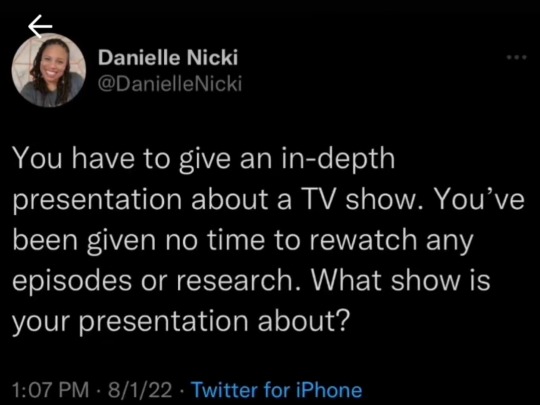
mutuals do this
79K notes
·
View notes
Text
about
you can find me on twitch here -> Twitch here is the youtube vod channel -> YouTube here’s my moodboard blog -> blog here’s my AO3 -> link
CURRENT STREAM SCHEDULE
Tuesdays 6-8/9pm EST - Moon Mystery short break to play True Fear 1 + 2
Saturdays 5-?pm EST - Minecraft or Mimic Logic
21+
I block empty blogs. if you don’t have an icon or blog title or anything to indicate you’re a real person and not a bot, I’m going to block and report you. if you’re a real person, I’m sorry about that but I implore you to at least put “lurker” in your bio. something to say you’re real
call me Will, Eli or potato idc
he/they
queer masc nb
currently crying about Outer Wilds and Bloodborne
currently on a Minecraft kick
ask me about literally anything idc as long as you’re civil about it
feel free to babble in my inbox about something you love or are enjoying
I have a writing/art blog (its just moodboards tho)
some tags! (now with links!!)
if you want to look at cute things check out my cute tag (literally just #cute tag)
if you need a laugh look at #laugh tag or #for bad days
my own text posts are tagged with #potato talks, feel free to rb them as long as they aren’t tagged with #personal
DEFINITELY feel free to ask about my ocs
my various (unfinished or general musing) writings are tagged with #potato writes fic
stuff that’s just dialogue is #potato writes dialogue
finished stuff goes in the tag #potatoes finished fics
I also have a crafts tag #potato does crafts (and more specifically, if you want to see a cool glow in the dark dragon I’ve been embroidering for the last few years go to #the dragon)
if you’re on mobile, you can find all these tags in the search bar, I have them as my recommended tags
Various writing things under the cut (tags to be added later when i'm not falling asleep)
current OCs I am on my Bullshit™ about:
Lunu (Outer Wilds OC/the Protagonist) (my sweet child)
Teagan (Elden Ring/Bloodborne OC/main character) (my bastard™ child)
Astra (literal embodiment of the Void. end of everything. has a flock of immortals they protect)
Ekkehard Reiher (DS2 protag) (very gay) (adores his daughter)
WIPs/AUs I’d love to talk about:
old man hunter & his eldritch child — bloodborne au where Gehrman + Teagan get yeeted into the past bc Teagan refused to abandon him and in doing so, uses up a lot of power and turns into a child 🥰 they bite people 🥰 it’s a comedy of errors. everyone is convinced Teagan is Gehrman’s biological child. they are not
Teagan kills a bunch of gods — what it says on the tin. Teagan returns to Yharnam after the hunt to piece their memories together
Teagan in the Lands Between (or Teagan doesn’t realize becoming Elden Lord means they’ll be nobility again) — takes place after the previous fic. contains Teagan being awkward and relearning how to be a human or at least how to pretend to be human. also contains Teagan adopting/being adopted by old men. its a running joke at this point
Lunu, Hearthian, Troublemaker, Traveler — novelization of an Outer Wilds playthrough
unnamed romcom without the romance. there will be no romance — a Bloodborne AU that takes place earlier in the timeline of the general hunt. Teagan gets forcibly dragged back to Orilon and their mother tries to marry them off. Maria’s cousin goes “yeah sure I’ll get fake engaged to you :)” and they go from having attempted to kill each other to grudging friends. he makes heart eyes at his actual partner in the background a lot. i do not have anything actually written down for this but its fun and I’m enjoying it
Dragonborn — skyrim fic. Jeven, my Dragonborn, returns to Skyrim to figure out the deal with her weird dreams and gets more than she bargained for with dragons. feat. Sheogorath making comments in the back of her head, Jeven stealing cheesewheels and forks, Jeven adopting almost every child she comes across, avoiding going to High Hrothgar for months, mod quests + locations, Jeven being gay for Lydia, dragons who refuse to shut up in Jeven’s head
Dragonborn time travel — because of Reasons™ Jeven, Miraak and Alduin get thrown into the past to before Torygg’s death. Alduin is extremely upset about this as he is now a small mortal and helpless child because of Reasons™. Miraak is trying to seduce Jeven’s brother. she is very horrified by this
#potato talks#cute tag#for bad days#laugh tag#potato writes dialogue#potato writes fic#potatoes finished fics#potato does crafts#the dragon
0 notes
Text
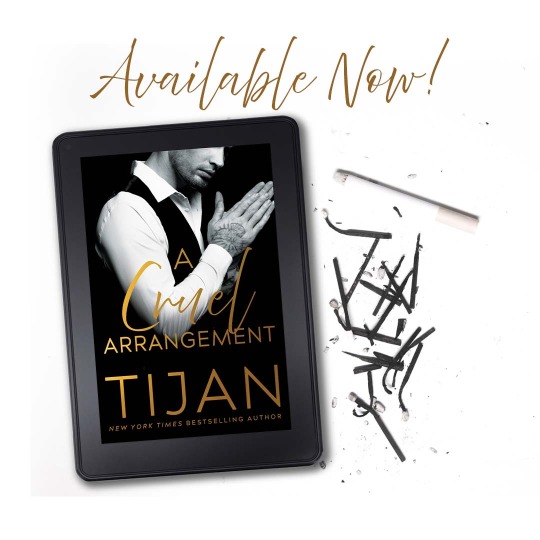

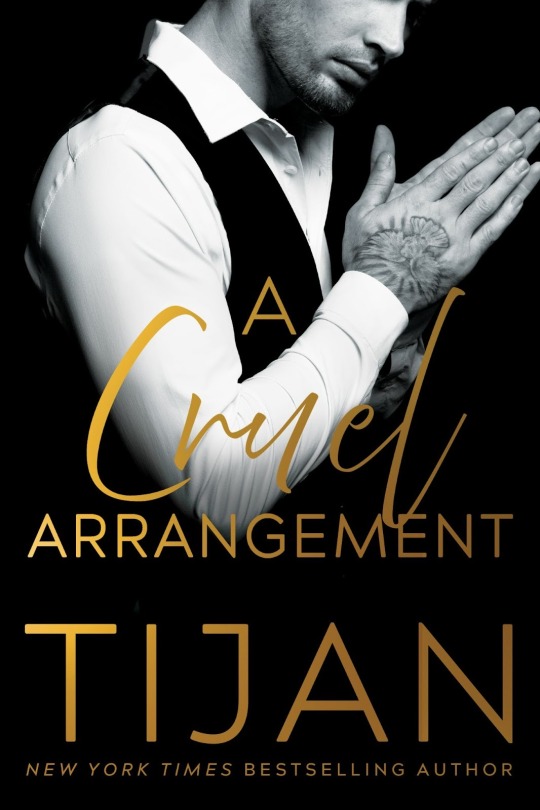
A Cruel Arrangement by Tijan is now live!
This was my place. My business. Easter Lanes.
Then a guy comes in, trying to rob me, daring to take it away from me.
My home. My life.
Hell no. I won't let my livelihood be threatened.
No one knows what I've done to build this life for myself.
Except he might.
Ashton Walden, a man I remember from when we were kids.
Even back then I could tell how dangerous he would be one day.
He's now the head of the Walden mafia family, and my father is so in debt to them that they practically own him.
My dad and I are estranged and I want nothing to do with him or his debt, but the day after the attempted robbery, I don't wake up in the hospital.
I wake up in Ashton Walden's home. And he drops a bomb on me.
If I want my livelihood back, I need to earn it back.
And thus begins our cruel arrangement.
Download today or read for FREE with Kindle Unlimited
Amazon: https://bit.ly/3D8g10k
Amazon Worldwide: https://mybook.to/CruelArrangement
Add to Goodreads: http://bit.ly/3wp933c

Meet Tijan
Tijan is a New York Times Bestselling author that writes suspenseful and unpredictable novels. Her characters are strong, intense, and gut-wrenchingly real with a little bit of sass on the side. Tijan began writing after college and once she started, she was hooked. She's written multi-bestsellers including the Fallen Crest series, Ryan's Bed, Enemies and others.
She is currently writing many new books and series with an English Cocker she adores.
Connect with Tijan
Website: http://www.tijansbooks.com/
Goodreads: https://www.goodreads.com/author/show/4851199.Tijan
Amazon: https://www.amazon.com/Tijan/e/B00DJG52QE
Facebook: https://www.facebook.com/Tijansbooks/
Facebook Group: www.facebook.com/groups/tijansreadergroup
Instagram: https://www.instagram.com/tijansbooks/
Twitter: www.twitter.com/tijansbooks
TikTok: www.tiktok.com/@tijan_author
Bookbub: https://www.bookbub.com/authors/tijan
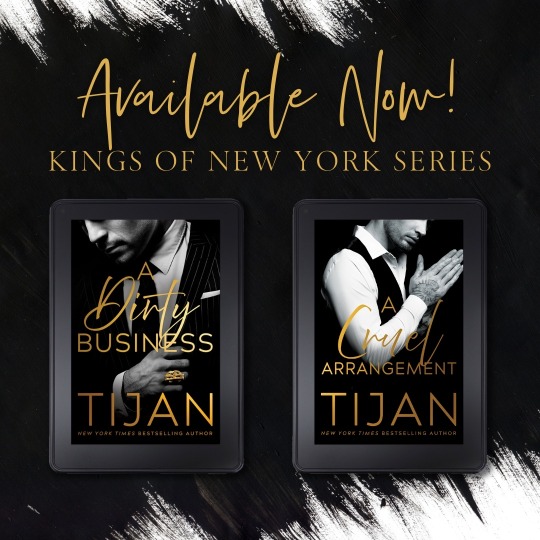
My Review
5 ⭐️⭐️⭐️⭐️⭐️
Get ready! This story had me on the edge of my seat, unable to stop reading from the beginning until the end. This author brings pure perfection in this intense, powerful, mafia world/enemies to lovers romance story, that may be unconventional but it was oh so captivating. Action packed, full of thrilling danger, violence, death, cruelty, ruthlessness, as well as filled full of a sizzling, steamy romance.
This is Molly Easter and Ashton Walden journey to a HEA and I was mesmerized by every word of this romance! These two have been part of a world that was not of their choosing, but one they were born into. Meeting each other at a young age, they never were close until one night when Molly’s world, Easter Lanes was threatened and her switch came into play. Usually she was kind and pure but not when backed into a corner and over reacted or irrationally overreacted or worse.
Ashton was the complete opposite to Molly. He was now the head of the Walden Mafia family, and he was dark, intense and cruel and he loved that part of his world. But now she was part of the war that his family was involved in which meant she was his business now. And the forced proximity that it created made the itch he had for Molly keep intensifying! And Molly well she had her own attraction for him as well. It was so amazing to see them both change and be so tuned in to each other becoming what the other needed.
“Unlike Trace, I liked being cruel. I liked killing. I liked the ruthlessness of this world, but I’d been holding back for him, for my brotherhood with him, for his woman, for my very delicate relationship with Jess, but Molly-she was a whole other factor.”
This was so well written and I loved how this all played out. I also loved all the secondary characters and getting more of Trace and Jess. I hope there is a spin off from this world, and if there is I will be anxiously waiting!
Received an early copy and this is my honest review.
#newrelease#tijansbooks#Tijan#Kings of New York Series#A Cruel Arrangement#mafia romance#netgalley#valentine pr#acruelarrangement#ashtonandmolly#spreadsomeashton
1 note
·
View note
Text
MOON TALES - Design notebook #4
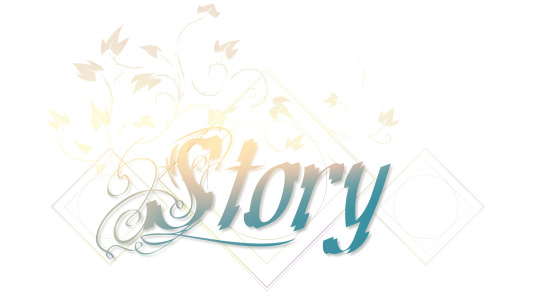
[ Version française cliquez ici ]
The Moon Tales* design notebooks invite you to discover a making-off of this project. They will present you its history, its development, as well as our desires, choices and questions. They also reveal a little more about this new universe, through its characters, places, etc.
* If you don't know Moon Tales, more info at this link.
You will find at the end of this English version of the notebook a list (and links) of all the notebooks already written. You will also be able to read the reasons for the existence of these notebooks.
Since always, men stimulate their imagination to tell stories. They imagine how the world is supposed to work, create fictitious friends and enemies, impart wisdom and morality, and simply pass the time. The most beautiful legends have crossed the centuries and have been taken up by many civilizations. We even find their archetypes, their struggles in the current media.
The story of Moon Tales borrows from a whole collective imagination, from a part of these legends and archetypes. From these, we will humbly attempt to build our own world, a new narrative that will hopefully be worthwhile. This new notebook is an opportunity for Pierre to tell you more about the subject !
A NEW GOLDEN AGE OF STORYTELLING
In my opinion, ours is a wonderful time for the imagination. Fantasy and its variations have become mainstream. You can't take the subway without running into people reading A song of ice and fire, Miss Peregrine's Peculiar Children or even Harry Potter. The shelves of bookstores, both real and virtual, are full of references and authors and I feel like everyone - even me - has tried writing a fantasy novel in their spare time.
And what about tv shows ? Game of Thrones has been an incredible success (which I think is deserved), and has paved the way for all adaptations and original creations. Streaming video platforms compete to adapt the most famous novels, often with many freedoms.
Not all - book, games, shows… - series work, however. I have many discussions with my friends, also avid readers, about the merits and pitfalls of this or that author. We often come back to the same point. What makes a good novel, a good episode, a good video game. For me, it revolves around one question : what makes a good story ?
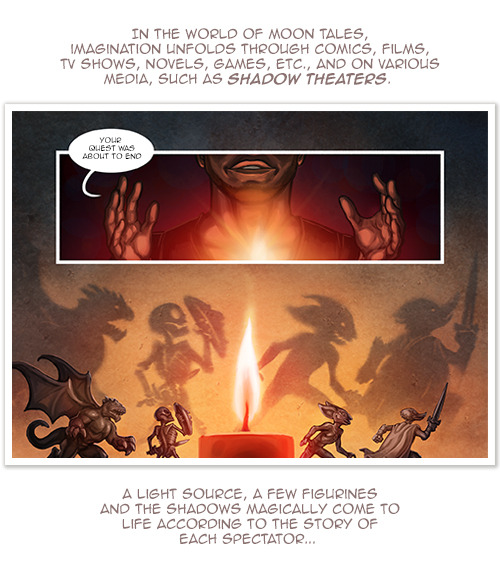
RECIPE FOR A SUCCESSFUL STORY
It seems to me that a captivating narrative lies in its actors. They are heroes to whom we get attached. We must feel empathy for them, identify with them, suffer or rejoice with them. They must be human, resonate with us. I am talking about hero(in)es here, but this rule can also apply to their enemies. A good villain is best when his or her motives are understandable and he or she is ambiguous - although we all have certain enemies we love to adore because they are so deliciously malevolent.
In Moon Tales, Akhiles is an example of a character that grew in size as we conceptualized the story. When Boris introduced me to his first ideas - a geeky, fashion-addicted man - I wondered what I was going to do with him. Now it's hard to imagine what the story of Moon Tales would be like without him.

Once the protagonists are defined, a general plot is needed – I put this criterion second because good characters can, in my opinion, create and maintain their own story, in relation to intimate objectives linked to their aspirations, their relationships... I'm talking about a main plot as opposed to the character-specific drama mentioned, because it will guide the narrative - without it the story is just a soap opera.
Finally, you need a setting.
The ideal case is when the author can afford to add a moral to his story, which makes it an educational lesson. G.K Chesterton said : « Fairy tales do not tell children the dragons exist. Children already know that dragons exist. Fairy tales tell children the dragons can be killed. » There is no need to say anything else, no one ever said anything better than this quote.
I've used this approach many times in various pieces of writing – I'm not saying it's the best, just that it's my vision.
For Moon Tales I had to throw everything away. Because of (or thanks to...) Boris.
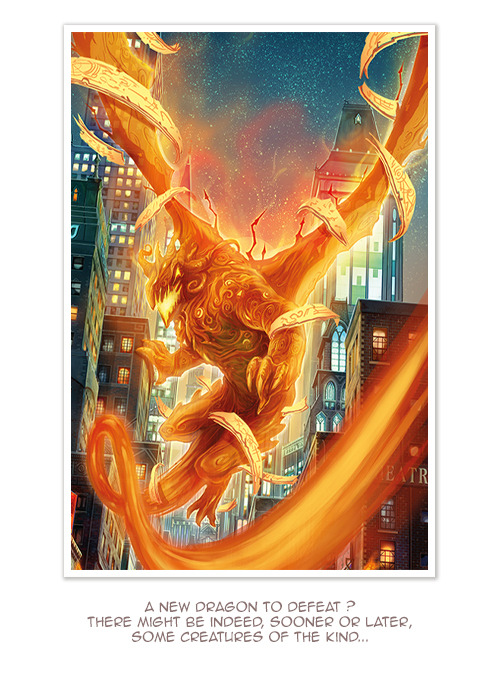
FREEDOM WITHIN CONSTRAINT
I already had ideas, and I have a rather free approach to creation where I throw out, ask myself what the characters would do and then let the world expand around them, adding other protagonists, to serve the needs of my plot. So happy was I.
Boris had a vision.
He wanted some characters. They were already well detailed, with appearances, behaviors, staging already prepared (sometimes storyboarded).
He had very precise ideas of the scenes he wanted to draw, the number of hero(in)es he had to create (to make his character design...). Worse for me, he wanted to make a precise map of the city in which their adventures would mainly take place, so that his settings would be coherent.

IDEAS THAT INTERWINE
[Boris] I'm hacking this notebook for the time of an insert to underline a little more the advantages of working together that Pierre evokes - certainly by making me look like the one who imposes a lot of things, but in reality, it's a little more nuanced and shared than that ^^
Whether it is for the creation and development of the characters, the world or even the story, everything is discussed. When one of us comes up with an idea, it will usually be accepted, but it will also be an opportunity to give new ideas to the other, to build on or refine the idea in question. Or to extrapolate new things and thus enrich the whole. Sometimes the ideas clash and a choice has to be made, or the two ideas have to be modified slightly to merge them. It is even possible that an inconsistency or an error is used to our advantage ! The stories, characters and world are not yet all developed in detail, which allows us real freedom and flexibility to regularly add new elements and discuss their interest.
For example, regarding Tamara, the first ideas about her past date from long before the writing of her introduction episode*. In the latter, Pierre raised new questions about this past and provided new details. So we discussed it to make it coherent and develop it a little more.
Another example where the creation of a visual can also serve the development of the world and the story** : Pierre introduces a line of kings, I make a visual of them by drawing a bit special crown, which then triggers the writing of new articles about it, enriching the world and its magic. Discussion after discussion, these new elements are linked to other details of the world developed long before, which leads to new visual ideas... Etc., etc.
In the end, all these developments "by bouncing off" are certainly part of the most exciting aspects of such a collaboration !
* : yes, each character will have an introduction episode, it's even the first seven chapters of Moon Tales !
** : a drawing can carry as much creativity and information as a text, and is therefore not a simple visual support for the latter. This is particularly true in creative fields that require the development of an imaginary world (role-playing games, for example), in which visual artists could be just as much a source of "creative material" (background, lore, fluff..., for those who know these words) and be qualified as authors in the same way as the people who write the texts... as long as the visual and written design are done in parallel and not one before the other.

I suddenly found myself creating a plot that had to go through specific steps, with situations that I honestly never would have thought of (I discovered things...). I admit that I was scared. Once I got over my stress, I started to work and I discovered a real freedom in these constraints. The latter forced me to structure my narrative, to pace it. These unexpected situations took me in directions I wouldn't have gone and made the story much fresher to me.
Some examples among others :
- Boris had the idea of a weekly publication, scheduled all over the year. This meant giving a rhythm to the text, but also thinking of Christmas or summer episodes... And so at Christmas time in our country, it had to snow in the webcomic. Same for the summer, we needed a sunny place, a beach...
- A cartoonist is a lazy person***, especially when he has to draw large amounts of panels. So I had to discipline myself and limit the number of characters per scene, avoid chaining new places or creating too complicated settings. Of course sometimes I couldn't resist it. But Boris went along for the ride and I hope you'll see in our opening vignettes that it was worth it.
- The publication format and its periodicity directly influence the style of the webcomic. The episodes must be short, some are only small interludes, others are a little longer, generally follow each other but are still thought to be a minimum of stand-alone. If it gave us ideas that might not have been attempted otherwise, it had a direct effect on my writing.
*** Note from Boris : please send your letters of protest and insults directly to Mr. Coppet, on his facebook page or any other address you may find. I will not relay (unless the message is on the comments pages of this notebook, see links below). Anyway, I've already taken care of breaking his kneecaps. Because as long as the arms and hands are working, the Moon Tales show can go on and that's the most important thing, isn't it ?


BUT WHAT IS MOON TALES REALLY ABOUT ?
Moon Tales is an encounter between two people from two different worlds. She is a girl from our Earth, he comes from a magical city on the other side of the mirror. But it's not that simple. She's probably wackier than he is. And they are accompanied by equally important individuals : a flamboyant hidalgo, an adventuress who hardly hides her weaknesses, a witch who wants to be a fairy, a sad oracle and a funny player. This constellation of personalities will illuminate a city of wonders plunged into darkness both literally and figuratively.
But before the beginning of our story, 37 years ago to be exact, you should know that a great war took place which strongly changed the life of its inhabitants. Once ruled by a hereditary dynasty of kings, the city in which these tragic events ended passed into the hands of an emergency revolutionary government, the time for Duana - the goddess of the night, equated with the moon and destiny - to appoint a new leader. The Sinister - the administration - thus took the reins of the city, pretending to be the executors of the Dexter, the council of the great families, of which the ancient kings were the leaders.
Today, the city bends under the yoke of the Sinister, but remains a magical place, with an enchanting, gothic and halloweenian atmosphere.
These axis will thus impregnate our story and the global atmosphere of our world, by mixing with several narrative genres. Small overview :
Halloween and Gothic : The world of Moon Tales is, among other things, a mixture of The Nightmare before Christmas and Tim Burton's Batman. One lives there in the shade of old manors and vertiginous skyscrapers. The urban wildlife probably has more owls and bats than rats and pumpkins are probably the national vegetable. If there are no scarecrows in the streets, it is likely that they are a people like any other with their own festival once a year. Since the fall of the monarchy, the great city has been plunged into an endless night that facilitates the apparitions of ghosts, witches and other nocturnal peoples.
Faerie : Moon Tales is not a horrific universe... most of the time ! The peoples of the night live in more or less good harmony under the yoke of the Sinister. Very few horrific crimes here. Haunting, cursing and enchanting are honorable professions. As for the fairies and the forces of light, they are all equally present as our heroes prove.
Urban fantasy : the introduction of our adventure is a classic urban fantasy - the discovery of Wonderland. It is with Follet, human of the Faded world, that we discover this other modern world full of magic as well as its shining city. The latter, a character in its own right, is a typical contemporary urban metropolis, even if often much more extravagant than those on our Earth, with its mysterious nooks and crannies and its sometimes strange inhabitants.
Soap : from the beginning we wanted a story centered on our characters, their relationships, their evolution, their friendships and their loves. I call it dramaturgy. Boris, who has little culture but loves cleanliness, talks about Soap. Bof.
Pulp adventure : friends of nature and cows, Moon Tales will not be limited to a darkened city. Beyond this, we give ourselves the opportunity to explore adventurous lands scattered with ruins, to make our characters discover the secrets or wonders of these places.
In the end, Moon Tales is an opportunity to mix comics, role-playing games and influences that we like in our witch's cauldron, to stir it all up well and, we hope, to please ourselves - and you.

But in the end, will our webcomic offer a good story ? It's hard for me to say. I am generally a good audience – I only ask a movie or a book to entertain me and I have so many guilty pleasures in terms of a simple or even failed plot that I love it all the same... Only our readers will be able to decide if they like our characters and their stories. We have already planned several years of adventures for them.


A DIFFERENCE IN MEDIUM
You don't write for a game the same way you write for a novel or a comic book. It sounds obvious when you say it like that, but I foolishly thought at first that narrating would be easier than proposing a storyline. Fatal error.
In role-playing game, you must first define a setting, a world, a situation and a motivation. From there, we think about the solutions that the players will think of, knowing that in the end they will do what we didn't plan. The rule is always, in my opinion, to propose things and not to close the doors.
In a novel, you have to think about continuity. A character comes with motivations, reasons and a personality. Not all choices are logical, and sometimes the logical choices for a protagonist are not those of the author. You have to put yourself in someone else's shoes. At the same time, the author must remember that the character does not know what he knows, they must find reasons to make them go from one scene to another, provide them with the keys that will allow them to solve the plot. In a sequential medium like Moon Tales, this means planning well in advance what to introduce. The universe, on the other hand, may be more fluid, less framed and less detailed, as it must serve the narrative (with one caveat, the Boris clause, see above).
These are therefore two fundamentally opposed approaches. The Yin and Yang of the written creation in a certain way :)



PIERRE’S MOOD NOTE
Today, as I write these lines in March 2022, the sirocco lifts the sand of the Sahara and brings it to us several hundred kilometers away. The sky has a strange color, yellow-orange. Sand is falling on our roofs. It is soothing.
In Ukraine, rainfall is deadly. No peace for men, women and children.
Moon Tales is about two overlapping realities, but there is no need to use magic for that. The real world reminds us of this every day.


Moon Tales' design notebooks exist first of all to keep track of the development of the project. They are written as much for us as for those who may be interested - now or in the future - in the underside of its development. Putting all these steps in writing gives us food for thought about our practices and our choices, so that we can draw out possible avenues for improvement. Finally, these notebooks make it possible to bring the project to life, before its "real" existence, and to show that it is moving forward.
NOTEBOOKS INDEX : #1 : Origins #2 : Characters (1) #3 : Drawing #4 : Story #5 : The City (2024)
[ Note : you can comment this post on my Facebook, Twitter or Instagram ]
***
French version below
MOON TALES - Carnet de conception #4

Les carnets de conception de Moon Tales* vous proposent de découvrir un making-off de ce projet. Ils vous en présenteront l’histoire, son développement, ainsi que nos envies, nos choix et interrogations. Ils dévoilent également un peu plus ce nouvel univers, à travers ses personnages, ses lieux, etc.
* Si vous ne connaissez pas Moon Tales, plus d’infos à ce lien.
Vous trouverez plus loin, à la fin de la page, une liste (et les liens) de tous les carnets déjà écrits. Vous pourrez aussi y lire les raisons d’exister de ces carnets.
Depuis toujours, les hommes titillent leur imaginaire pour se raconter des histoires. Ils imaginent un fonctionnement à l’univers, se créent des amis et des ennemis fictifs, transmettent une sagesse, une moralité, et simplement passent le temps. Les plus belles légendes ont traversé les siècles et ont été reprises par de nombreuses civilisations. On retrouve même leurs archétypes, leurs déchirements dans les médias actuels.
L’histoire de Moon Tales emprunte à tout un imaginaire collectif, à une part de ces légendes et de ces archétypes. À partir de celles-ci, nous tenterons humblement de construire notre univers, un nouveau récit qui, espérons-le, sera digne d’intérêt. Ce nouveau carnet est ainsi l’occasion pour Pierre de vous en dire plus sur le sujet !
UN NOUVEL ÂGE D'OR DE LA NARRATION
Nous vivons une époque merveilleuse pour l’imaginaire selon moi. La Fantasy et ses déclinaisons sont devenues mainstream. On ne peut plus prendre le métro sans croiser des personnes en train de lire un tome du Trône de Fer, les Enfants Particuliers de Miss Peregrine ou même encore Harry Potter. Les rayons des librairies, réelles comme virtuelles, regorgent de références et d’auteurs et j’ai l’impression que tout le monde – même moi – s’est essayé à écrire un roman de Fantasy à ses heures perdues.
Et que dire des séries ? Game of Thrones a fait un succès incroyable (que je trouve mérité) et a ouvert la porte à toutes les adaptations et aux créations originelles. Les plates-formes de streaming vidéo rivalisent pour adapter les romans les plus connus avec souvent beaucoup de libertés.
Toutes les séries ne fonctionnent pas cependant. J’ai de nombreuses discussions avec mes amis, eux aussi grands lecteurs, sur les mérites et les écueils de tel ou tel auteur. Et on en revient souvent au même point. Qu’est ce qui fait un bon roman, un bon épisode, un bon jeu vidéo. Pour moi, cela tourne autour du même point : qu’est ce qui fait une bonne histoire ?

RECETTE POUR UNE HISTOIRE RÉUSSIE
Il me semble qu’un récit captivant tient dans ses acteurs. Ce sont des héros auxquels on s’attache. On doit ressentir de l’empathie pour eux, se retrouver en eux, souffrir ou se réjouir avec eux. Ils doivent être humains, résonner en nous. Je parle ici des héro(ine)s, mais cette règle peut également s’appliquer à leurs ennemis. Un bon méchant est d’autant meilleur que ses motivations sont compréhensibles et qu’il est ambigu – bien qu’on ait tous certains ennemis qu’on adore adorer tant ils sont délicieusement malveillants.
Akiles est un exemple de personnage qui a pris de la dimension alors que nous conceptualisions l’histoire. Lorsque Boris m’a présenté ses premières idées - un homme geek et accro à la mode - ,je me suis demandé ce que j’allais en faire. Désormais, il est difficile d’imaginer ce que serait l’histoire de Moon Tales sans lui.

Une fois les protagonistes définis, il faut une intrigue générale – je mets ce critère en second car de bons personnages peuvent, selon moi, faire naitre et entretenir leur propre histoire, en rapport avec des objectifs intimes liés à leurs aspirations, leurs relations... Je parle ici d’une intrigue principale par opposition au drama propre aux personnages évoqué, car elle va canaliser la narration – sans elle l’histoire n’est plus qu’un simple soap opera.
Enfin il faut un décor.
Le nec plus ultra est le cas où l’auteur peut se permettre de rajouter à son histoire une moralité, qui fait d’elle une leçon éducative. G.K Chesterton disait : « Les contes de fées n’enseignent pas aux enfants que les dragons existent. Les enfants le savent déjà. Ils leurs enseignent que les dragons peuvent être vaincus. » (« Fairy tales do not tell children the dragons exist. Children already know that dragons exist. Fairy tales tell children the dragons can be killed. »). Il n’y a pas à dire, c’est la classe.
J’ai utilisé cette approche plusieurs fois dans divers travaux d’écriture – je ne dis pas qu’elle est la meilleure mais simplement que c’est ma vision.
Pour Moon Tales j’ai dû tout jeter en l’air. À cause de (ou grâce à…) Boris.

LA LIBERTÉ DANS LA CONTRAINTE
J’avais déjà des idées, et j’ai une approche de la création assez libre où je lance des pistes, me demande ce que feraient les personnages puis laisse le monde pousser autour, d’autres protagonistes se rajouter, pour servir aux besoins de mon intrigue. Bienheureux que j’étais.
Boris avait une vision.
Il voulait des personnages. Ils étaient déjà bien détaillés, avec des apparences, des comportements, des mises en scène déjà préparées (voire storyboardées).
Il avait des idées très précises de scènes qu’il voulait dessiner, du nombre de héro(ine)s qu’il devait créer (pour faire son character design…). Pire pour moi, il voulait faire une carte précise de la cité dans laquelle se déroulerait principalement leurs aventures, afin que ses décors soient cohérents.

DES IDÉES QUI S'ENTREMÊLENT
[Boris] Je pirate ce carnet le temps d’un encart pour souligner un peu plus les avantages du travail commun qu’évoque Pierre - certes en me faisant passer pour celui qui impose beaucoup de choses, mais en réalité, c’est un peu plus nuancé et partagé que ça ^^
Que ce soit pour la création et le développement des personnages, ceux du monde ou même de l’histoire, tout se discute. Quand l’un de nous vient avec une idée, celle-ci sera généralement acceptée mais elle sera aussi l’occasion de donner de nouvelles idées à l’autre, de rebondir dessus afin de développer ou d’affiner l’idée en question. Ou d’extrapoler de nouvelles choses et ainsi d’enrichir l’ensemble. Parfois, les idées se confrontent et il faut faire un choix, ou bien modifier légèrement les deux idées pour les fusionner. Il est même possible qu’une incohérence ou une erreur soit utilisée à notre avantage ! Les histoires, les personnages et le monde ne sont pas encore tous développés en détails, ce qui nous permet une vraie liberté et une grande souplesse pour intégrer régulièrement de nouveaux éléments et débattre de leur intérêt.
Par exemple, concernant Tamara, les premières idées à propos de son passé datent de bien avant l’écriture de son épisode de présentation*. Dans ce dernier, Pierre a soulevé de nouvelles interrogations quant à ce passé et a apporté de nouveaux détails. On en a donc discuté pour rendre le tout cohérent et le développer encore un peu plus.
Autre exemple où la création d’un visuel peut aussi servir au développement du monde et de l’histoire** : Pierre introduit une lignée de rois, j’en réalise un visuel en leur dessinant une couronne un peu spéciale, ce qui déclenche ensuite l'écriture de nouveaux articles à ce sujet, enrichissant ainsi le monde et sa magie. Discussions après discussions, on relie ces nouveaux aspects à d’autres détails du monde développés bien avant, ce qui entraîne de nouvelles idées visuelles… Etc., etc.
Au final, tous ces développements “par rebonds” font certainement partie des aspects les plus passionnant d’une telle collaboration !
* : oui chaque personnage aura un épisode de présentation, il s'agit même des sept premiers chapitres de Moon Tales !
** : un dessin peut porter tout autant de créativité et d’informations qu’un texte, et n’est donc pas qu’un simple support formel à ce dernier. C’est particulièrement vrai dans les domaines créatifs qui nécessitent de développer un monde imaginaire (le jeu de rôle par exemple), dans lesquels les illustrateurs pourraient tout autant être source de “matériel créatif” (de background, de lore, de fluff..., pour ceux qui connaissent ces mots) et être qualifiés d’auteurs au même titre que les personnes qui en écrivent les textes... pour peu que la création visuelle et écrite se fasse en parallèle et non l’une avant l’autre.

Je me retrouvais soudain à créer une intrigue qui devait passer par des étapes précises, avec des situations auxquelles honnêtement je n’aurai jamais pensé (j’ai découvert des choses…). J’avoue que j’ai eu peur. Mon coup de stress passé, je me suis mis au travail et j’ai découvert une vraie liberté dans ces contraintes. Ces dernières m’ont obligé à structurer ma narration, à la rythmer. Ces situations inattendues m’ont emmené vers des directions où je ne serais pas allé et rendent le récit bien plus frais à mes yeux.
Quelques exemples parmi d’autres :
- Boris avait l’idée d’une diffusion hebdomadaire, planifiée dans le temps. Cela signifiait rythmer le texte, mais également penser à des épisodes de noël, estivaux… Et donc qu’au moment de noël chez nous, il fallait qu’il neige dans la bd. Pareil pour l’été, il nous fallait un lieu ensoleillé, une plage…
- Un dessinateur c’est feignant***, surtout quand il doit dessiner des cases en grandes quantités. Donc j’ai dû me discipliner et limiter le nombre de personnages par scènes, éviter d’enchainer les nouveaux lieux ou de créer des décors trop compliqués. Bien sûr parfois je n’ai pas su m’en empêcher. Mais Boris a joué le jeu et j’espère que vous verrez dans nos vignettes de début que ça en valait la peine.
- Le format de publication et sa périodicité influent directement sur le style de la bande dessinée. Les épisodes doivent être courts, certains sont seulement des petits interludes, d’autres sont un peu plus longs, se suivent généralement mais sont tout de même pensés pour être un minimum autonomes. Si cela nous a donné des idées qui n’auraient peut-être pas été tentées autrement, il y a eu un effet direct sur ma façon d’écrire.
*** Note de Boris : merci d'envoyer vos lettres de protestations et d'insultes directement à monsieur Coppet, sur sa page facebook ou toute autre adresse que vous trouveriez. Je ne ferai pas le relais (sauf si le mot a lieu sur les pages de commentaires de ce carnet, cf. lien plus bas). De toute façon je me suis déjà chargé de lui casser les rotules. Car tant que les bras et les mains fonctionnent, l’histoire de Moon Tales peut continuer et c’est bien là l’essentiel, n’est-ce pas ?


MAIS EN FAIT MOON TALES ÇA PARLE DE QUOI ?
Moon Tales est une rencontre, entre deux individus de deux mondes différents. Elle est la fille de notre Terre, il vient d’une cité magique de l’autre côté du miroir. Mais ça n’est pas si simple. Elle est sans doute plus farfelue que lui. Et ils sont accompagnés d’individus tout aussi importants : un hidalgo flamboyant, une aventurière qui cache difficilement ses faiblesses, une sorcière qui se veut fée, une oracle triste et un drôle de joueur. Cette constellation de personnalités va illuminer une ville de merveilles plongée dans l’ obscurité au sens propre autant que figuré.
Mais avant le début de notre histoire, 37 ans auparavant pour être exact, sachez qu’une grande guerre eut lieu qui changea fortement la vie de ses habitants. Autrefois gouvernée par une dynastie héréditaire de rois, la cité dans laquelle ces tragiques événements prirent fin passa en effet aux mains d’un gouvernement révolutionnaire d’urgence, le temps pour Duana – la déesse de la nuit, assimilée à la lune et au destin – de désigner un nouveau chef. La Senestre – l’administration – prit ainsi les rênes de la ville, en se faisant passer pour les exécutants de la Dextre, le conseil des grandes familles, dont les anciens rois étaient les dirigeants.
Aujourd’hui, la cité plie sous le joug de la Senestre, mais reste un lieu magique, à l’atmosphère enchanteresse, gothique et halloweenienne.
Ces grands axes vont ainsi imprégner notre récit et l’ambiance globale de notre univers, en se mélangeant à plusieurs genres narratifs. Petit panorama :
Halloween et le gothique : le monde de Moon Tales est, entres autres, un mélange de l’Etrange Noël de Monsieur Jack mais aussi du Batman de Tim Burton. On y vit à l’ombre de manoirs anciens et de gratte ciels vertigineux. La faune urbaine comporte sans doute plus de hiboux et de chauves-souris que de rats et les citrouilles sont probablement le légume national. S’il n’y a pas d’épouvantails dans les rues, il est vraisemblable que ce soit un peuple comme les autres avec leur propre festival une fois par an. Depuis la chute de la monarchie, la grande cité est plongée dans une nuit sans fin qui facilite les apparitions de fantômes, de sorcières et des autres peuples nocturnes.
Féerie : Moon Tales n’est pas un univers horrifique… la plupart du temps ! Les peuples de la nuit vivent en plus ou moins bonne entente sous le joug de la Senestre. Très peu de crimes horribles ici. La hantise, le maléfice et l’enchantement sont des professions honorables. Quant aux fées et aux forces de la lumière, elles sont toutes aussi présentes comme le prouvent nos héros.
Urban fantasy : l'introduction de notre aventure est un classique de l’urban fantasy – la découverte du pays des merveilles. C’est au travers de Follet, humaine du Monde éteint, que nous découvrons cet autre monde moderne plein de magie ainsi que son étincelante cité. Cette dernière, un personnage à part entière, est une métropole urbaine contemporaine typique, même si souvent bien plus extravagante que celles de notre Terre, avec ses recoins mystérieux et ses habitants parfois étranges.
Soap : dès le début nous avons voulu une histoire centrée sur nos personnages, leurs relations, leur évolution, leurs amitiés et leurs amours. J’appelle ça de la dramaturgie. Boris, qui a peu de culture mais qui aime la propreté parle de Soap. Bof.
Aventure pulp : ami(e)s de la nature et des vaches, Moon Tales ne se limitera pas à une ville enténébrée. Au-delà de celle-ci, nous nous donnons la possibilité d’explorer des terres d'aventures parsemées de ruines, de faire découvrir à nos personnages les secrets ou merveilles de ces lieux.
Au final, Moon Tales, c’est l’occasion de mélanger bande dessinée, jeu de rôle et des influences qui nous plaisent dans notre chaudron de sorcière, de bien touiller tout cela et, nous espérons, de nous – et de vous – faire plaisir.

Mais en fin de compte, notre webcomic proposera-t-il une bonne histoire ? Difficile pour moi de le dire. Je suis en général plutôt bon public – je ne demande à un film ou à un livre qu’à me distraire et j’ai tellement de plaisirs coupables en terme d’intrigue simple voire ratée que j’adore tout de même… Nos lecteurs seuls seront à même de décider s’ils aiment nos personnages et leurs histoires. Nous leur avons déjà prévu plusieurs années d’aventures.


UNE DIFFÉRENCE DE MEDIUM
On n’écrit pas pour du jeu comme on écrit pour un roman ou une bande-dessinée. Ça a l’air évident dit comme ça, mais j’ai bêtement cru au début que narrer serait plus facile que de proposer une trame. Fatale erreur.
En jeu de rôle, on doit d’abord définir un cadre, un univers, une situation et une motivation. De là, on réfléchit aux solutions auxquelles vont penser les joueurs tout en sachant qu’en fin de compte ils feront ce que l’on n’avait pas prévu. La règle est toujours, selon moi, de proposer des choses et de ne pas fermer les portes.
Dans un roman, il faut penser à la continuité. Un personnage vient avec des motivations, des raisons et une personnalité. Tous les choix ne sont pas logiques et, parfois, les choix logiques pour un protagoniste ne sont pas ceux de l’auteur. Il faut se mettre dans la peau d‘un autre. En même temps, l’auteur doit se souvenir que son personnage ne sait pas ce qu’il sait lui, il doit trouver des raisons de le faire aller d’une scène à l’autre, lui fournir les clés qui lui permettront de résoudre l’intrigue. Dans un support séquencé comme Moon Tales, cela signifie de prévoir bien à l’avance ce qu’il faudra introduire. L’univers, par contre, peut-être plus fluide, moins cadré et moins détaillé, car il doit servir l’intrigue (avec un bémol, la clause Boris, cf. supra).
Ce sont donc deux approches fondamentalement opposées. Le Yin et le Yang de la création écrite d’une certaine façon :)



LE BILLET D'HUMEUR DE PIERRE
Aujourd’hui, alors que j’écris ces lignes en mars 2022, le sirocco soulève le sable du Sahara et le porte jusqu’à nous à plusieurs centaines de kilomètres. Le ciel a une couleur étrange, jaune-orangée. Il tombe du sable sur nos toits. C’est apaisant.
En Ukraine, les précipitations sont meurtrières. Pas de paix pour les hommes, les femmes et les enfants.
Moon Tales parle de deux réalités qui se chevauchent mais il n’est pas nécessaire de faire appel à la magie pour cela. Le monde réel nous le rappelle chaque jour.


Les carnets de conception de Moon Tales existent d’abord afin de garder une trace de l'élaboration du projet. Ils sont écrits autant pour nous que pour les personnes susceptibles d'être intéressées - dès à présent ou dans le futur - par les dessous de son développement. Poser par écrit toutes ces étapes nous donne matière à réfléchir sur nos pratiques ainsi que nos choix, pour en tirer éventuellement des pistes d’amélioration. Enfin, ces carnets permettent de faire vivre le projet, avant sa “vraie” existence, et de montrer qu’il avance.
INDEX DES CARNETS : #1 : Origines #2 : Personnages (1) #3 : Dessin #4 : Histoire #5 : La Cité (2024)
[ Note : vous pouvez commenter ce billet sur mon Facebook, Twitter ou Instagram ]
#2022#moon tales#moon tales notebooks#moon tales webcomic#moon tales characters#tamara#malys#akiles#akhiles#moon tales world#projects#moon tales rpg#ttrpg#webcomic#storytelling#story writing
2 notes
·
View notes
Note
Did you name your novels or were they just ShoH 1, ShoH 2, ShoH 3, etc.? (If yes, can you also tell their names please?)
Hi there, thanks for the question! In my head they were Volumes 1-20-something--actually, if you’ll believe it, in my head for a long time I named the books after colors, and somehow kept track... but at some point I did put a formal list of potential titles together. I never used the “real” titles mentally, except for The Bridge of Bones, Fortress of the Dead, and the books in Series II and III: I still remember thinking of the first book in Series I as “red” and the second book as “orange”... 😬 And the files/scenes in each book were labelled “aaa”, “bb”, “++”. The more letters there were, the number of times the scene had been rewritten (so “a” was a first draft of the first scene in the book, and “aaa” was the same scene, but more polished... what was I thinking?)
Anyway, I had to go digging to remember my ideas for the titles of some of the earlier books, so please forgive any cringyness lol, I was pretty young when I wrote Series I! I also don’t know if these are all of the ShoH novels--these are just the main chronological ones, but there were some spin-offs and AUs that I don’t name here!
Series I: World Without End
The Witching Wheel
Blood and Fire
Gunpowder Magic
Battle Mage
The Knife That Spoke
Oathbreaker
Shadowsight
The Code of War
The City of Midnight
The Foundling’s Soul
The Silver Covenant
The Gates of the Earth
Child of the Stars
Series II: The Storm of the Worlds
The Thunder March
The Lightning War
The Conquered Sky
Series III: The Land of the Gods
The Eternal Sea
The Country Cloaked in Moon
Bridge Series:
Fortress of the Dead
The Bridge of Bones
The Razor Crown
The God-King’s Sun
Series IV: The Naming of All Things
Harlequin
Valkyrie
Jeremiad
The Council of Kingmakers
Canticle of the Namer
The Blessed Isles
Read below if you want as concise of an explanation for these titles as I can provide!
In case you’re curious, Series I up until Battle Mage follows the protagonist, Arainia, as a young girl (I think 11 or 13) after the death of her mother, being sent to Solhadur amidst family conflict with her father and older sister, her various adventures there at school (meeting Red, Pan, Neon, etc.), graduating, attempting to join the Ket army (it’s complicated), and then deciding to join the Shepherds at around 18 or 19. She undergoes training in the academy, joins her squad (this is where Trouble, Riel, Chase, Halek, and the rest come in), and becomes a Shepherd officer alongside her childhood best friend Blade in Battle Mage. The Knife that Spoke and onward details various missions, investigations, battles, recruitments, and adventures that they all embark on as young adults into their twenties, with some books following different perspectives in the squad (Blade, Riel, Trouble, Chase, Halek, Red, Wintry, and Junoth [the last two not in the game] all get their turn narrating a book or at least a large part of one), with Shery, Ayla, Mimir, Lavinet, Tallys, Neon, Croelle, and many other characters featuring heavily. Around this time, civil war is brewing between the Elves, Ket, and certain factions of Mages, and Endarkened attacks soon begin to rise as the Order struggles to keep the peace.
Series II details the outbreak of total world war that is essentially the Castigation in the game, with Western Norm kingdoms and territories suddenly and unexpectedly marching on the East--except in the novels, demons and demon armies are also involved, and the war is ultimately averted/ended in a truce as both sides finally unite to confront the Endarkened. It’s during this time period that Riel defects and seemingly betrays the group in favor of “the other side.” Blade is also seemingly killed at the end of the first book of this series and doesn’t reappear again until the third book, Arainia is captured and held as a prisoner of war all while thinking her best friend is dead, and it’s an upsetting time for everybody. Junoth also actually dies. RIP. Croelle pops in to save the day!
Series III details the aftermath of the war and a mission to find unoccupied land for displaced factions of soldiers, diplomats, traders, and civilians from the Norm territories (led by Riel), leading to a voyage across the Mirror Sea to explore the vast continent to the south of Blest, called colloquially “the Land of the Gods.” The second book in this series is also when Blade and Arainia FINALLY confess their feelings for each other and get together, and the big love triangle in the series is finally mostly settled. Oh, but things also aren’t perfect because the Order forbids relationships between officers (like they’ll actually be fired, not Blade’s lame rule in the game lmao), so they live in fear of being discovered because neither wants to quit being a Shepherd! Their hope is that Blade will be named Commander when the current one resigns, and then he can just... change the rule LOL.
The Bridge Series has some companion novels that take place in between Series III and IV; Fortress of the Dead is Croelle-centric (this is when he informally joins the Order in the books) and The Bridge of Bones details some political bullshit and coups and conspiracies within the Order when its Commander dies unexpectedly and seemingly names a shady outsider (Edric) as the new Commander instead of Blade. The group is placed on different squads to split them up and prevent rebellion from brewing (it happens anyway), and it’s all very crazy. This is also when Lavinet sort of becomes a good guy, Shery becomes a badass, Shyf Cian first appears as the HR rep everyone hates, and this book is also pretty Chase-centric (he pretty much saves the day) and features a Mage serial killer, a psychopathic criminal syndicate leader, and an evil Changeling! I think it’s my favorite novel of the series. From what I remember, The Razor Crown and The God-King’s Sun are just super angsty for no good reason other than I guess I felt like writing a lot of angst--though the God-King’s Sun is also the first appearance of a true Autarch in the series.
By the time we get to Series IV, the characters are in their thirties, settling into adulthood and their respective roles in life. Blade finally assumes command of the Order, Blade and Arainia get married, Halek and Wintry have a baby (Kana!), Halek turns 33 and has a life crisis, Arainia gets pregnant (and then kidnapped for a large part of her pregnancy lolll), Riel and Chase finally make reluctant peace, some other stuff happens, uh there’s some Mimir stuff in there, Red successfully makes a trip to another world, and Arainia gives birth to a Ket-Mage son in... I think it was either The Canticle of the Namer or The Blessed Isles.
So... yeah! 28+ main novels, and I’m still going, just for me! 😂 I tend to write a lot of AUs of the series in my off-time, though sometimes the AUs are just “what if this took place in the same world but things are totally different--like what if they were politicians instead of Shepherds, what if the Shepherds functioned differently due to a different historical event occurring, what if the Castigation happened but it was Mages who instigated it, what if they were soldiers in a war 5000 years before the main series takes place, etc.”; or they take place in totally different worlds, like the characters as cops in a modern world that has cell phones and cars but also still has the Diminished races and magic somehow!
Thanks for your question, and for reading this long talk! 😅
#...#damn#that's a lot when you list it out lol i just usually hazily think of it as a handful of books but it's like 30 D:#some of these are novellas though!#most of the bridge series except for the bridge of bones are#Shepherds of Haven#ironically 'shepherds of haven' was never used as a title#novel#novels#original novel#original novels#titles#long#long post#anon
87 notes
·
View notes
Text
Sitting Front Row at...(On a Budget Obvs): Lookbook no.15
Hey to anyone reading!


And welcome to my fave lookbook I’ve done in a longggg ass time! Yes, that’s partially because it involved making collages and doing the low effort work of scouring Vogue Runway for “research purposes”, but I promise, that statement wasn’t made out of COMPLETE laziness-I am super happy with it too. It’s been a good use of pre-part-lockdown-lift time in the interim between that brief period of Christmas celebrations and eateries finally fucking opening again because let’s be honest, I always knew I was gonna get distracted by oat milk vanilla lattes and veggie all day breakfasts once I could actually sit down with them at my fave local cafe. You could say I was very much operating on a self-imposed deadline.
The “what I would wear to sit front row at...[insert designer here]” TikTok/Instagram reel trend was something I wanted to get on board with ever since I first saw one and whilst the option of doing my own live action take-I really cannot bear the thought of having to edit footage of myself awkwardly attempting to sit nonchalantly in front of a camera for hours on end-was off the cards considering my complete lack of screen presence, I decided a Tumblr text post would work just as well, and if not even better in a way. Given the absence of the time limitations you face when you’re making a reel or a TikTok I thought it’d be cool to present the looks as part of a mini moodboard for each designer which adds a bit of context to each look even if you aren’t familiar with their past collections and establishes the general vibe of the brand I’m attempting to replicate. Not to sound snotty or as if I am the font of all knowledge on anything high fashion related but even with my amateur knowledge I noticed that as the video trend took off and was adopted by big name influencers, it became less about the average person putting their own personal spin on the aesthetic of the labels we can’t ordinarily afford and more about them building outfits that only vaguely resemble the general public perception of the brand around the real corresponding (and often gifted and thus inaccessible to someone who doesn’t makes thousands for a sponsored post) pieces they own SO I thought I’d take the trend back to its roots and get a bit resourceful. All that being said, in no particular order, here are the outfits I would wear to sit front row at Gucci, Vera Wang, Miu-Miu, Marc Jacobs, Dolce & Gabbana, Brock Collection, Alexander McQueen, Etro, Burberry aaaand Saint Laurent based on their past collections and guess what? They didn’t cost a shit tonne of money :-)
-disclaimer: will include an asterisk before any new purchases if from a high street store though to be honest, I don’t think there are any, we shall see! I do include where I got old purchases from in case anyone wants to search anything on Depop/Ebay-
1. Saint Laurent (formerly Yves Saint Laurent)
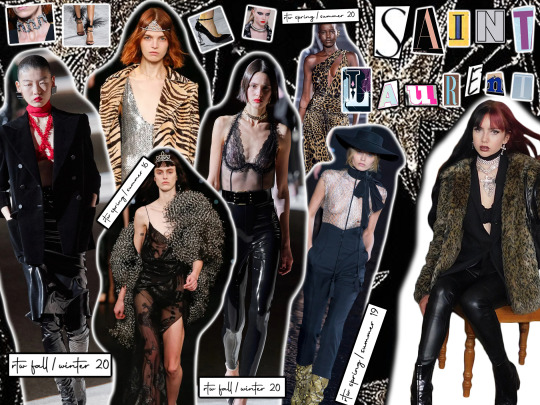
-blazer from identityparty on Depop, pleather trousers from Zara, jewellery from Dolls Kill-
I know technically abbreviating Saint Laurent to YSL doesn’t really make much sense anymore given the brand’s name change in 2012, but I’ll always think of it as that in the same way I’ll always associate it with the slightly dishevelled yet simultaneously glitzy rock n’ roll aesthetic. The thing is, whilst YSL hasn’t done anything wildly out of the box for a long time, it’s rare they put a look on the runway that I wouldn’t wear; they never end up being a fashion week standout but the Parisienne take on grunge we’ve seen Anthony Vaccarello establish as his go-to will always have a place in my heart.
2. Alexander McQueen
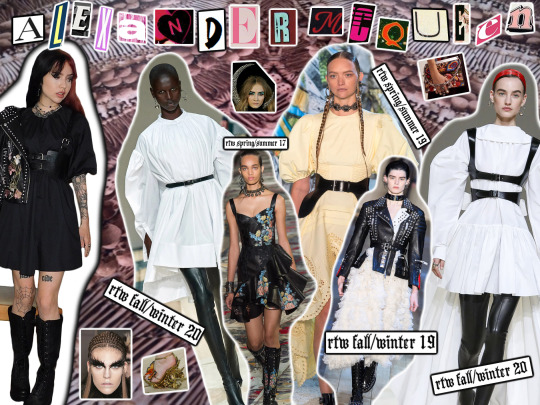
-embroidered leather jacket from Ebay (originally Topshop), harness from Amazon, dress from ASOS, boots from Koi Vegan Footwear-
Alexander McQueen is a brand that is pretty much universally liked, from the historically extravagant and groundbreaking shows the man himself put together to Sarah Burton’s more toned down but still beautiful collections. Obviously I didn’t attempt to do justice to the former, so I tried my hand at putting together a look inspired by Sarah’s blend of delicate femininity and nomadic edge, and it went...okay? Like it’s definitely not my favourite of all the looks because it does give off slightly cheap copycat vibes buuut outside of the context of this lookbook it’s cute.
3. Brock Collection
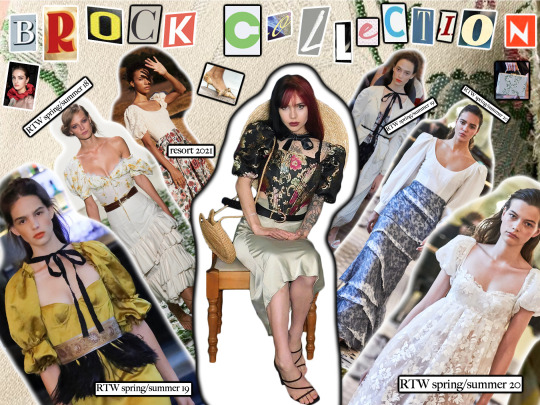
-boater hat from Ebay, midi skirt from morganogle on Depop, corset top from ownmode_, heels from amybeckett1, bag from Primark-
Brock isn’t as well known a brand as most of the others in this list but I adore everything Laura Vassar Brock does and I couldn’t pass up an opportunity to try and channel the vision of one of the OG pioneers of the cottagecore vibe through my own wardrobe. I mean fr, this woman’s work as a steady provider of meadow photoshoot worthy dresses and corsets and skirts is v slept on and I will not stand for it. I will sit in front of a camera and then write a paragraph in my blog post begging anybody who reads to give LVB (an abbreviation I acknowledge is unlikely to catch on because Lisa Vanderpump anybody?) some form of acknowledgement for her services to period romance novel inspired moodboards everywhere.
4. Marc Jacobs
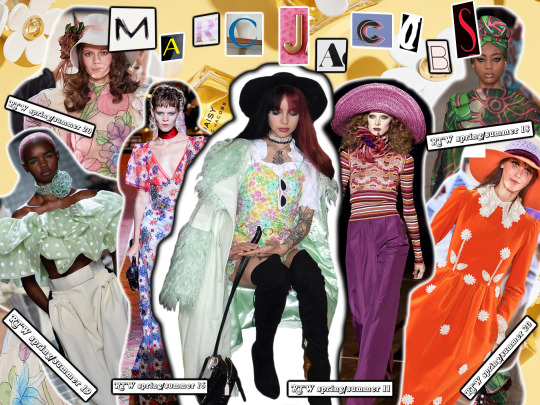
-coat from House of Sunny, white shirt from Retro World Camden, co-ord from Sugar Thrillz, bag from Poppy Lissiman-
If there’s one thing Marc Jacobs always does, it’s COMMITS. TO. HIS. THEME. I just KNOW he has a secret Pinterest with separate boards for every fashion era of the 20th century and he is putting those boards to good use providing us with collections that are as immersive as they are eclectic year in year out.
5. Miu Miu
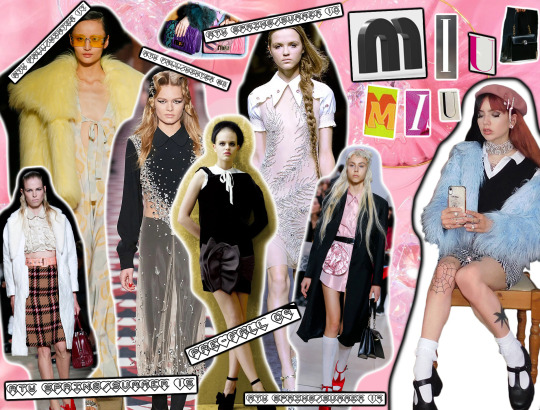
-beret from H&M, hair clips from H&M, jewellery from Primark, coat from mollyyemmaa on Depop, shirt from YesStyle, sweater vest from YesStyle, skirt from Depop, diamanté belt from Brandy Melville, shoes from Koi Vegan Footwear-
We all like to talk about Bratz dolls and Monster High dolls and Barbies as fashion inspo but can we all focus on Cabbage Patch dolls for two secs so as to acknowledge the fact that a Miu Miu collection is basically all their fits grown up? And made boujie as fuck? If I want my fix of Wes Anderson meets Scream Queens (what a combo) inspired outfits, if I want prissy and girlish but also glam, if I want to look like a bratty rich girl whose one redeeming quality is her eye for vintage clothes, I know where to look and that is the Miu Miu section of Vogue Runway.
6. Vera Wang
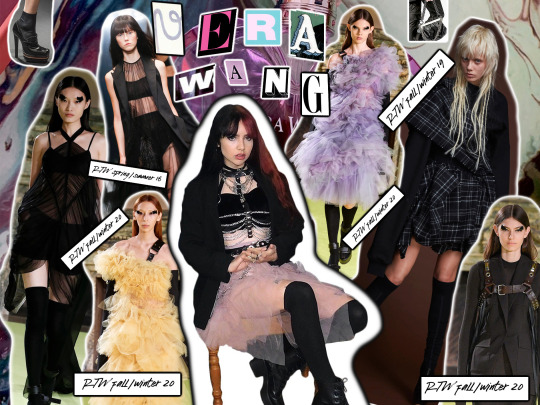
-blazer as in no.1, velvet bralet from catdegaris on Depop, harness from Amazon, skirt from Ebay, knee high socks from Ebay, lace up boots from Ebay-
Vera Wang’s RTW aesthetic, a blend of the ethereal, ultra-feminine bridal designs she’s known for and British style punk rock influences, is something I feel has only become firmly established in recent years but it is everything I ever wanted and more. I always find myself trying to balance the part of me that loves everything girly and delicate and pretty and the part of me that would love to be in a biker gang and Vera’s collections are always an inspirational reminder of just how well it can be done.
7. Burberry
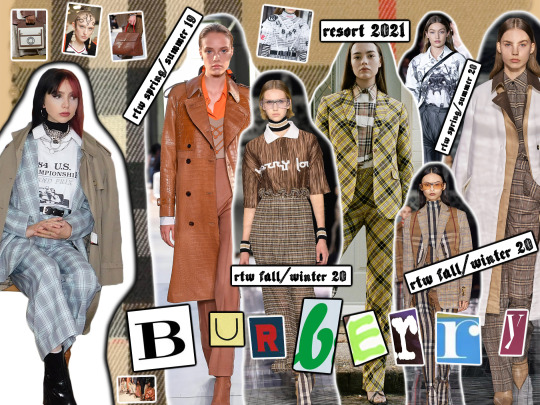
-coat from charity shop, suit from emmafisher3 on Depop, top from simranindia, shirt underneath from Zara, jewellery from ASOS-
Now I’m not gonna lie, I’m not the biggest fan of Burberry but there have been a few looks over the past few years I’ve really liked and as someone who owns numerous trench coats, high necks and way too much plaid, I thought it’d be an easy one to replicate. Plus, if you can count on Riccardo Tisci for nothing else you at least can rely on him giving you some layering inspo which is very much needed in a country where it literally just snowed in April and where my plans for today have just been cancelled because the iPhone weather app did a Karen Smith and didn’t predict rain for today right up until it started raining so thanks for that one British meteorologists. Your incompetence strikes again.
8. Etro

-corset from Urban Outfitters, vinyl trench coat from Topshop, boots from Ebay, black slip dress from kaoanaoleinik on Depop, fur trim afghan coat from louisemarcella-
Like with Brock Collection, Etro isn’t a hugely well known brand, but it is always one of my favourites-to add a spanner into the works of any attempts to cultivate a firm sense of personal style, I live for the ornate Bohemian look that Etro does so well just as much as I love both grungy and girly pieces, and so I really wanted to include a brand whose collections go down that route. It was a toss-up between this and Zimmerman, the flirtier, free spirit counterpart to the dark romance of Veronica Etro’s designs; her vision really shines through the most when it comes to the brand’s winter collections, imo, and given that I live in a country where winter or some weather state resembling it does seem to take up 70% of the year, I did decide on channelling her work rather than that of the equally talented Nicky and Simone Zimmermann this time round.
9. Dolce & Gabbana
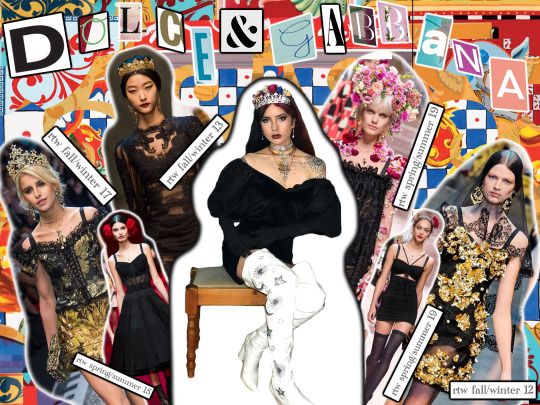
-flower crown from ASOS, tiara from Amazon, earrings from YesStyle, dress from alicealderdice1 on Depop, opera gloves from Ebay, boots from Koi Vegan Footwear-
D&G is a brand I felt really conflicted about doing-I don’t include their current collections in my fashion week reviews based on the actions of designers Stefano Gabbana and Domenico Dolce over the last few years because I don’t want to mitigate the collective effort of fashion critics to push them towards irrelevancy. Though people like to claim the brand has turned a corner since Lucio Di Rosa was brought on board as the manager of celebrity and VIP relations last year (they are as prolific a force on red carpet fashion as ever), we haven’t seen any real meaningful apologies or reparations made by Dolce and Gabbana themselves which once again leaves us in the all too familiar quandary of whether or not we can separate the art from the artist especially when it is far too much of a simplification to only credit the two men for their work given there’s a whole design team behind them. There are a LOT of shitty people working in fashion, the whole industry is a bit of a cesspit if we’re honest, but I don’t think that should stop us from at least being able to appreciate old collections if we make sure we aren’t engaging in any kind of promotion of current works whilst doing so. D&G are a brand of high highs and low lows, with looks that range from hideously ugly to showstoppingly beautiful in a single show-when the looks are good, they are GOOD-and their presence in the fashion world is most definitely felt whether we want it to be or not. It would just be shit to refuse to recognise the existence of some real iconic runway moments, the practical work that went into the ornate detail and opulence that helped cement D&Gs place in sartorial history, the styling that’s made goddesses and fairytale queens out of modern day women as they’ve glided down catwalks, the far more extravagant and, let’s be real, sexier version of our world D&G shows have transported us to in the past. Will I talk about D&G ever again? No, and if you Google the scandals their brand has faced over the past few years, there are more than enough reasons why, but just this once I did want to pay homage to some of the collections, the snippets of which I saw on my Tumblr dashboard back when I was about 13, that first got me into fashion.
10. Gucci
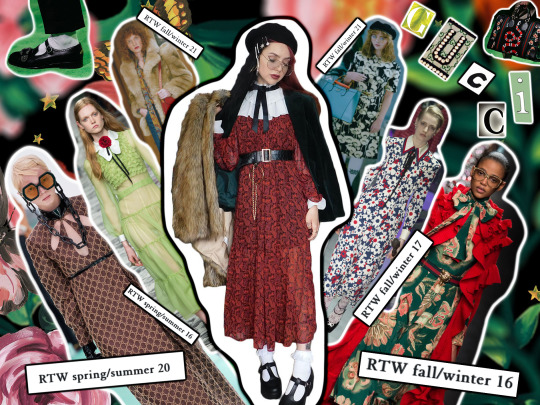
-fur coat from Topshop, clips from Zaful, glasses from Ebay, dress from gracewright246 on Depop, shirt from Boohoo, blazer from charity shop-
Now last but, if you ever read any of my fashion week reviews (the likelihood of someone actually having read one of them and reading this is incredibly, incredibly slim lol, I wouldn’t read me either) you’ll know, definitely not least, is Gucci because Alessandro Michele comes through every!! single!! time!!
The man is truly the king of quirky throwback maximalism and it hurts my heart that a lot of people seem to think of it only as a brand associated with ostentatious displays of wealth. Year after year since Michele was made creative director he has released purposeful, fully-fleshed out collections which unravel themselves to us on the runway like time capsules containing the belongings of the rich and whimsical and yes that can sometimes result in outfits which are *ahem* a bit mismatched but it doesn’t matter because through fashion he manages to take us to a vivid version of the past where people could dress as freely and lavishly as they wanted to, into the wardrobe of a person unaffected by the side-eyeing of others. You get the impression he doesn’t design so much as plays around with some kind of enchanted dress up box and takes inspiration from there and to give that impression is only a credit to his talent-to make outfits so kooky and extravagant look like they were meant to be takes a boldness and genuine love for clothes that I do tend to feel a lot of the big name designers have lost in the pursuit of profit and the necessary placating of the dying customer base that keeps that coming in. Of course I'm not for a second saying Gucci does not care about profit, but at the very least, they have on board a creative director who genuinely has fun with what they’re putting out there and wants to make a statement too and that really shows; you can rest on your laurels and sell tweed boucle jackets to rich old white women for eternity but nobody’s going to mention your brand name and the word groundbreaking in the same sentence ever again unless they’re talking about what it was a century ago, you know (mentioning no names...unless...did I hear someone say Chanel)? That feels like such a shady way to end, lol, but I’m sure said brand will survive-to be fair, they’ve been included in every other What I’d Wear to Sit Front Row At video I’ve seen so although I’m always slagging them off for doing the saaaaame thinggggg year after year, for that same reason their aesthetic is instantly recognisable and so will always be a source of imitation. There are obviously pros and cons to being a brand which constantly reinvents itself but I think it’s totally possible to do that whilst maintaining an overall mission, and Alessandro Michele’s work at Gucci demonstrates that with ease.
Anyway, if you got to here, thanks for reading! I know I’m super behind on this whole TikTok trend and I know a Tumblr post instead of a video is a bit of a cop out but all the real, physically awkward ones out there know that watching yourself back is excruciating lmao, so I hope this does the trick. After this, I’m gonna get back to the reviewing S/S21 collections post though knowing me I’ll probs take a few days to get back into that because I feel like since I left full-time education (RIP me going back in a few months) writing continuously like this for any longer than about 15 mins fries what brain cells I have left. Again, thank you for reading and if you are, sending many good vibes your way! Stay safe!
Lauren x
#front row#frontrow#fashion#fashioninpo#fashion inspo#style#style inspo#designer#gucci#vera wang#burberry#label#miu miu#runway#fashion week#mood board#ysl#saint laurent#runway trends#ss21#lookbook#vintage#outfit#marc jacobs#Alexander mcqueen#runway fashion#high fashion#haute couture#trend#collage
40 notes
·
View notes
Text
I Care A Lot, Malcolm & Marie, Capone, The Life Ahead and the News of the World: Everything I watched in February.

Newsflash ! The cinemas still aren’t open and I’m starting to lose hope in them ever opening. Despite the UK government drawing a step by step guide into lifting the UK out of lockdown (like its flat pack furniture and not a critical pandemic) with cinemas due to open in April, I wouldn’t hold my breath seeing as our own human biology and its resistance is the actual measure of when it is safe to go out and about, not what our government says. So until everyone is vaccinated and has sustained the first few months of vaccination symptom free, I’m having to sift through Netflix and Amazon for something to watch, like I’m looking through a charity shop sale; without much luck. Don’t get me wrong, I’m all for these streaming services, I (my dad) pay for them for Christ’s sakes and I know that one day I’ll be eating my words when I’m offered a Netflix deal that I (in a Vito Corleone voice) “cannot refuse”. However, unlike some of the creators on Netflix, I’ll make the most of this opportunity and be incredibly anal about what I want to make, even if it kills me.
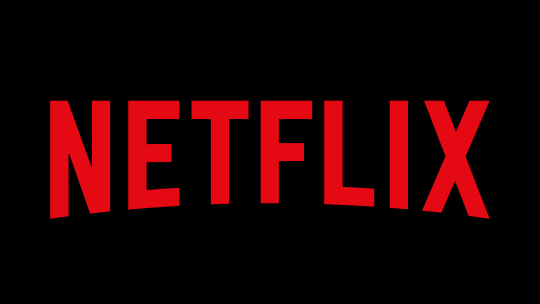
I feel like so many people are given the license to make whatever they want for Netflix and then I look at the trophy wall of Emmys that HBO has garnered over the years and consider their quality writers and casts. I would say most recently, shows like The Crown, Sex Education, Top Boy and Bridgerton are Netflix’s exceptions currently, being both of quality and giving us something we actually want to watch. And guess what all these shows have in common?! Not only are all the casts largely British but all productions of these shows are British too. The British quality of TV programmes for streaming services in the US is a win win for all; Americans get to watch our good quality TV and we get Golden Globes. Most notably, The Crown did exceptionally (as it always does) at this year’s Golden Globes, further proving the show's excellence despite controversy. I thoroughly praise Netflix's resistance to label the show “fiction” and the lengths it took in making the show as authentically as possible, despite the criticism. The awards speak for themselves and the Crown has scooped up several this year so far.
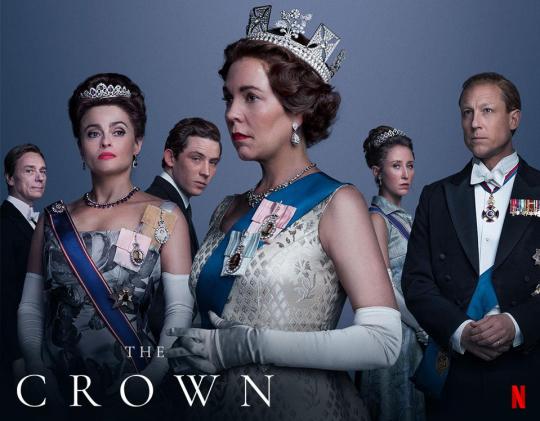
To conclude, I want the cinemas to open just as much as anyone, but I’m happy to comply with the stay-at-home-and-watch-Netflix-rule for now. For now...Here’s everything I watched this February.
Annihilation (2018) as seen on Netflix
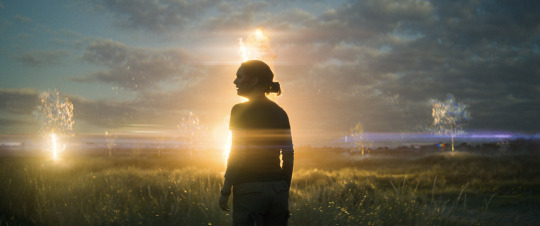
Netflix’s Annihilation starring Natalie Portman, Jennifer Jason Lee, Gina Rodriguez, Tessa Thompson and Oscar Issac was a multitude of things that were difficult to comprehend. This is not me saying this is a bad film, in fact its me saying the complete opposite as the complexity drew a tangible beauty to the film from beginning to end. I reeeaaalllyyy liked the beginning and how the first scene sucked you into the crazy and fanatical story that later unfolded. Natalie Portman as always was wonderful in this role, playing a biologist who enters another world in search of her husband, who’s gone missing on a similar expedition to hers. Like with most sci fi films, it was difficult to gather the meaning of such a film, however this lack of meaning didn’t draw away from the story or how it was portrayed, in slow and enigmatic shots that told the story with a natural pace. If you’ve seen / liked Ex Machina (2014), Annihilation has the same director and I would thoroughly recommend you watch this too as the way Alex Garland merges sci fi with horror is incredibly seamless.
Score: 10/10
Eastern Promises (2007) as seen on Amazon Prime

This film starring Naomi Watts, Viggo Mortensen and Vincent Cassel was incredibly dark and gritty. Even though I’m not Russian, I found Mortensen and Cassel’s Russian personas to be rather good for a Dane and a Frenchman. Their on screen chemistry was also really good and its make me wonder why I haven’t seen a film with these two in it before. The story follows Anna (Naomi Watts) a nurse and her hunt for the true identity and life of a baby that was born to a 14 year old girl. Nikolai and Kirill (Mortensen and Cassel) are Russian gangsters living in London and set about covering up this obscene scandal and getting rid of the product of it, a baby girl belonging to the condemned and now deceased child. It's a difficult plot to wrap your head around and like I said, it's incredibly dark. Actor and director David Cronenberg (A History of Violence 2005) directed this film and helped Viggo Mortensen with a nomination for Best Actor at the 2008 Academy Awards.
Score: 8/10
Fifty Shades of Grey (2015) as seen on Netflix

So remember how I said I was DESPERATE for films this month...I watched Fifty Shades of Grey with zero expectations and I can say definitively that it was worse than I thought. It's a true miracle that both Dakota Johnson and Jamie Dornan still have careers 6 years after such a film was released and I personally wouldn’t rush to cast either acting in my film after seeing this. Harsh, I know but reputation is everything and when you sign onto something that instead of highlighting your acting abilities, highlights your body parts, what am I supposed to think... I’m all for body confidence and what not, but I feel like most of this film sort of abuses sexuality and sexual expressions. The fact is, the BDSM part of this film wasn’t even that bad, it was the characters that pissed me off the most and their LACK of character in fact. They were orchestrated in such a flat way and the only time where either one of them found any character was through the sex itself and the discussion of it, especially Anastasia’s character. The most profound and irritating thing about this film is that Anastasia’s life seemed to only have meaning when she met the so called handsome, charming, wonderful, drop dead gorgeous Christian Grey. What does that teach us about women people? I’ve said it once, and I’ll say it again, sexualising women in film and media shouldn’t be the only reason for them to be there. And the entirety of Fifty Shades of Grey is built upon that fact. Even though the novel was written by a woman, it definitely missed the point in giving us a strong female character who could both be into sex and taken seriously at the same time. Seems like a really hard thing to do in cinema as filmmakers either go for the over-hyped sexualised prostitute, the caring mother or the nun. Like female professionals have never had sex in their lives… think again. I like to wonder what it would’ve been like had it been Ms Grey and Christian as her submissive. Not only would that mix up the character dynamic and go against gender confirmation, it’d actually be interesting. But maybe I should just write that story altogether...To conclude, the characters in this film were flat and the entirety of the film hyped up sex and the act of it way too much. It's like making a film about walking or breathing.
Score: 1/10
Malcolm & Marie (2021) as seen on Netflix

Malcolm & Marie received a lot of attention in the media and sadly not for the right reasons. In fact, what’s so childish about the backlash is that hardly any of it had to do with the filmmaking techniques Sam Levinson (Euphoria’s creator) used or the story he wrote. More of it had to do with Levinson’s controversial ideas about how the media likes to view and prod film like a goldfish in a bowl, acting ostentatiously towards the art and appearing woke as opposed to just seeing film for how it is. I gather many film critic’s egos were bruised when Levinson used the lead character, Malcolm (John David Washington) as a butcher to film critics. He says things like “I’m choosing to make a film that’s fundamentally political, but not everything I do is political because I’m Black” in reference to the ignorance of some film critics who stamp politics onto any black directed film, attempting to brand the films with their own understanding of the film as opposed to its real message and story. Malcolm spends the majority of the night loathing a fictional “white LA reporter” and betting on her exact words for his own film, about an African American woman trying to get off drugs. What he says is funny, so funny it's true. White reporters DO do this and instead of embracing Levinson’s satricalism, the real LA white reporters of our media got overly offended and used the “lack of story” card as a backdrop to fuel their distaste at being called out. Had they known Levinson’s intentions with this film, they wouldn’t have reviewed it all together as I’m sure Levinson knew what he was getting himself into when mentioning the annoying “white LA reporter” and making the stereotype central to the lead's frustrations towards the industry. Levinson also graciously mentions that even though Malcolm has such hatred towards the critics, he is their fuel and by making his so-called “art” he only joins them in the argument . Levinson made his bed when he made the film and I think he’s sleeping rather comfortably. No one even bothered to praise both Zendaya’s and Washington’s performances, which were phenomenal considering the circumstances and the added pressure of having to carry a whole story in one room using only each other to fulfil that story. The cinematography was ambitious and overall, it was a simple yet well executed story. What are y’all complaining about?
Let's put egos aside and focus on the actual film for once, rather than how its perceived the articulation of your opinions towards it.
Score: 10/10
Coming to America (1988) as seen on Amazon Prime
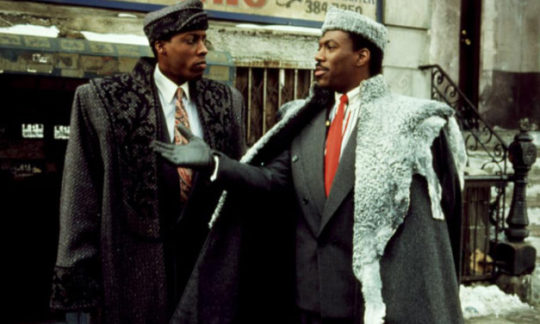
At this moment I truly was becoming a slave to streaming services. I wasn’t particularly leaping at the opportunity to watch this film, however I chose to watch it as I heard that Eddie Murphy was releasing a sequel this year. As someone who doesn’t like comedy, I found this rather funny in places but it's hard to laugh at the black stereotypes portrayed in such a film even when those stereotypes were perpetuated by a black person. There was also a lot of misogyny, something else that I don’t call comedy but just misogyny. I found it hard overlook these moments and kinda saw this element as the downfall to the film which detracted from any of the other comedic moments.
Score: 5/10
Do the Right Thing (1989) as seen on Amazon Prime
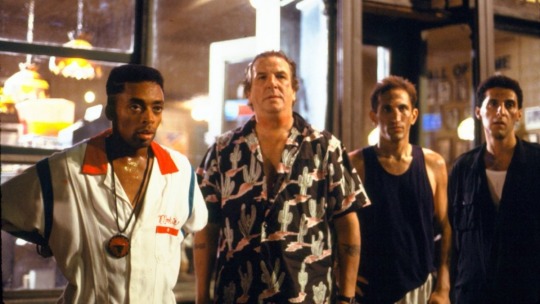
One of Spike Lee’s earlier films, Do The Right Thing is a film I’ve been dying to watch for quite some time. The film is like a fascinating book, with chapters on each of the plights of living in Brooklyn in the 1980s. Though it takes one character’s perspective, there are a multitude of other stories that can be found in this film, with them interlinking seamlessly and coming together at the end. This isn’t a film about race but rather one about anger and its potential to divide people, especially when things become heated and fingers are pointed. It covered a variety of perspectives which I like, almost like an episodic series where each episode is different and takes on a different character. This structure added variety to the film and allowed it to cover a multitude of topics in a small space of time. The structure of this film was only successful because its characters, who were funny, three dimensional and above all, had something to say. Director and writer Spike Lee played Mookie, the lead, a pizza delivery man and quite the f**k up on the streets of Brooklyn, using his mouth more than his actions to get by in life. I really liked the balance of moments of comedy and severity which had me laughing in places and immediately stopping afterwards. Well written and I commend Spike Lee for having written, directed and starred in the same film.
Score: 10/10
The Life Ahead (2020) as seen on Netflix
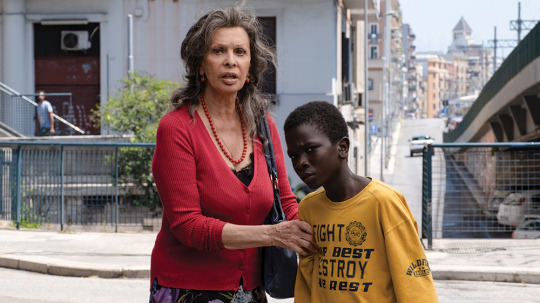
As an actress, Sophia Loren is one of my all time favourites. On seeing films such as A Special Day (1977) Two Women (1960) Marriage, Italian Style (1964), I began to appreciate the work of Sophia Loren and notice how much of an icon she still is today. Having picked up several awards over an expansive 71 YEAR career, she has been honoured many a time by the Golden Globes and Oscars as one of the finest actresses of all time. Her presence on screen is inspiring and she’s been often referred to as the Italian Marilyn Monroe for her beauty inside and out. Here at the age of 86, she plays a Holocaust survivor and foster mother who cares for a troubled boy in The Life Ahead. Loren’s character, Madame Rosa, eventually saving him from a miserable life thieving and selling drugs on the streets of Italian. Loren’s son, Edoardo Ponti directed this film for Netflix and was generous enough to give us Sophia Loren’s presence on screen once more by casting her in the film as the lead.
Score: 9/10
Gold (2016) as seen on Amazon Prime

I found Gold to be one of those talky, talky films that starts at the end and ends at the end (if that makes sense) which in my opinion isn’t the most courageous structure one could use, but is common in biopics. It either starts on the protagonist’s death bed or at the point where the police have just caught them and for Gold it was the latter. The appearance of women in this film was second to none and that’s not me saying the director should’ve added female characters for good measure or token but why make a film that only appeals to one demographic, despite the intensity of the story...film is universal after all and if a film appeals to one certain group then what’s the point of releasing it? This doesn’t detract from Matthew McConaughey’s performance though as a “prospector” looking for gold in Indonesia. Even saying this, the character was very typical of him and it didn’t truly stretch his ability as an actor, not like Dallas Buyer’s Club (2013), Killer Joe (2011) or Interstellar (2014) did. To sum up Gold into one word it’d be “meh”.
Score: 7/10
Creed (2015) as seen on Amazon Prime

This was one of the most surprising films of the month. I’m not crazy about the Rocky films nor see myself watching all of them anytime soon, but Creed appealed as a more modern take on the hit franchise. Michael B Jordan plays Adonis Creed, son of Apollo Creed, a champion boxer who died during a fight before Adonis was born. After being adopted by Apollo’s wife, Adonis Creed sets out to follow his father’s footsteps by becoming a champion heavyweight boxer himself, much to his maternal mother’s displeasure and his coach’s the one and only Rocky Balboa (Sylvester Stallone). The story is similar to that of Rocky and if anything, is a complete revival, using the son of one of Rocky’s former fighter as a backdrop to tell the story. Director Ryan Coogler (Black Panther 2018, Fruitvale Station 2013 ) brought this story to life and a courageous performance out of Michael B. Jordan. Not only was I fascinated by boxing by the end of the film, but just the whole idea of Adonis Creed, a fighter and not a quitter who thoroughly believes in pursuing your goals until they are obtained. Not only is this film for boxing fans but for those who share that same universal message and refuse to give into their own inhibitions to achieve great things. We should look to athletes more often in this respect and consider the pursuit of our own desires as boxing matches and marathon races more often as it helps put our fight into perspective and teaches us never to give in.
Score: 11/10
Arrival (2016) as seen on DVD
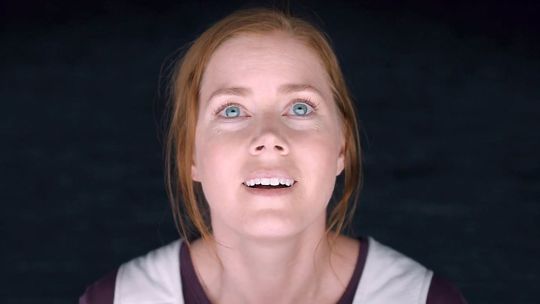
Before anyone comes for me for not having seen Arrival, before I was a movie buff I had briefly come across the film several times but had never taken the time to sit it out and watch it from beginning to end. I’m glad I did as Denis Villeneuve is one of my favourite directors evah and along with Christopher Nolan, I consider him as the King of Sci Fi. Every single one of his films is incroyable (as the french say) and it's a mystery why he hasn’t been handed an Oscar yet. Arrival is this slow and beautiful story of a linguistics teacher (Amy Adams) who agrees to help on a mission to communicate with extraterrestrial life forms that have landed on planet earth in the form of twelve huge spaceships. Structure isn’t something we typically consider when watching a film, but it plays such an important part in Arrival for time and the manipulation of it is the main theme of this film. Essentially, the language in which Dr. Banks translates from the intelligent life form gives its readers the ability to see into the future, which is when we come to realize that she’ll have a child, who will die of an unnamed disease. Despite this fact, she decides to live the life fate intended for her. The reason why Arrival is a highly credible film is because of the coverage it has as a film in terms of what it's trying to say as a film. From someone who finds it hard to bring out the emotion of a screenplay, Arrival is a great example to me as a film that combines both a cinematic feeling and a strong emotional presence throughout the film. It doesn’t abandon emotions or relationships just because the film is about aliens, but instead embraces them into the story and intertwines them with the aliens who’ve come to planet earth. At the end of the day, we can have explosions, spaceships and aliens galore, but if we’re unable to connect with characters on an emotional level then the film becomes boring. Arrival is far from boring and may bring a tear or two to your eye by the end.
Score: 11/10
The News of the World (2020) as seen on Netflix

I feel like it's impossible to hate a film with Tom Hanks in it and The News of the World definitely fits into that. Five years after the US Civil War, Cpt. Jefferson Kyle Kidd (Tom Hanks) spends his days travelling around the US ‘reading the news’ to anyone who’s willing to listen. The majority of the US was illiterate in the 19th Century, meaning it was up to people like Jefferson to inform others of the ongoings in the world by reading them the paper. It’s a wondrous thing to think about, how information was once spread throughout the world in such an archaic format. Jefferson did this off his own back, not asking for much and finding fulfilment in the reactions to the news that he “broadcasted” to them. Whilst on his travels, Jefferson comes across a young girl (Golden Globe nominee Helena Zengal) who’s negro family had been killed by lynchers. The girl was originally from a Native American tribe but had been separated by them, leaving her to fend for herself. When Jefferson comes across her, he’s reluctant to take her in at first but decides to take her to some relatives across the country. It’s definitely the role you expect of Tom Hanks and his heart warming nature is captured for us in this film for Netflix.
Score: 9/10
The Mask (1994) as seen on Netflix

It's hard for me to label The Mask as a good film as that would mean shaking off the horrendous amount of misogyny it has and the lack of diversity within its characters. Films mean different things for people, but ultimately most of them reflect an element of humanity and explore it on screen with originality and authenticity. Cameron Diaz’s character was only there to fulfil the sexual appetites of the men around her, which is something I loathe in female characters. Originality The Mask has, authenticity, not so much. That's probably the reason why I hate comedies so much, most of them are written by men and are about men so it can get quite boring to watch at times. I liked the idea of The Mask but it definitely could’ve been executed in a less misogynistic way.
Score: 5/10
Jackie (2016) as seen on Amazon Prime
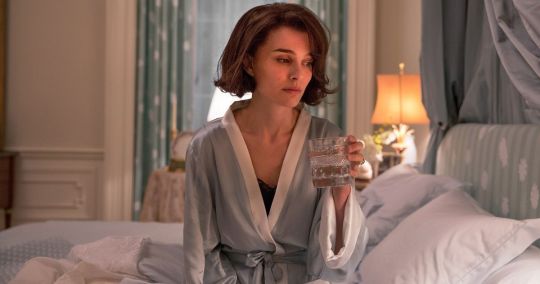
One word; perfection. This film was hands down one of the most beautiful, genuine and honest films I’ve seen in my entire life. It had me reminiscing Todd Haynes’ Carol (2015) in a number of ways, from the similar filmmaking techniques to the slow and melancholy atmosphere that was being created on screen. The AMAZING Natalie Portman plays Jackie Kennedy, wife of John F. Kennedy who was brutally assassinated on a visit to Dallas, Texas in 1963. The fact that I didn’t even KNOW that his poor wife was in the car with him at the point of the assassination is shocking. On watching the film, I learnt Jackie was a remarkable, brave and intelligent woman who after her husband's death put so much into preserving her husband’s legacy despite his lack of popularity. The way the film is shot and the music by the brilliant Mica Levi (Under the Skin 2013 , Monos 2019) just ties everything together into a enigmatic and wonderful film. Natalie Portman was nominated for Best Actress at the 2017 Academy Awards and rightly so. This film has further proven my thoughts on her as one of the greatest actresses of our time. I seriously cannot EXPRESS how much I love this film, directed by Chilean director Pablo Larraín, who’s also made another film that I can’t get enough of Ema, which was released 2 years ago.
Score: 12/10
Foxcatcher (2014) as seen on BBC iPlayer

When we first think of Steve Carell, our minds probably drift to his most notable performance as Michael Scott from The Office or even Gru in Despicable Me. It's rare for a so called “comedy” actor to find his way into films with a more dramatic substance and over the last few years, this is what Carell has been showing us on screen, with this role in Foxcatcher and more recently, in Felix van Groeningen’s Beautiful Boy (2018). Foxcatcher is the true story of a wrestler offered the opportunity to train with a private wrestling team owned by a huge chemical corporation. Channing Tatum plays Mark Schultz, a quiet and reserved wrestler who trains alongside his brother David (Mark Ruffalo), also a champion wrestler. What's sad to see in this twisted story is how validated Mark feels once the powerful and wealthy John Du Pont (Steve Carrell) begins to take an interest in him and takes him under his wing. This relationship drives a wedge between Mark and his brother David, but much to John’s displeasure, it doesn’t last long. This is definitely a story of power and how people can react in bad ways when they are owed too much of it. Every performance in this was astounding and the slow and subtle telling of the story was truly beautiful to watch. Foxcatcher is a film I’ve been dying to watch for some time and it DID NOT disappoint. Period. The film was also nominated for five Oscars back in 2015, including Best Actor and Best Supporting Actor.
Score: 11/10
In Fabric (2018) as seen on BBC iPlayer
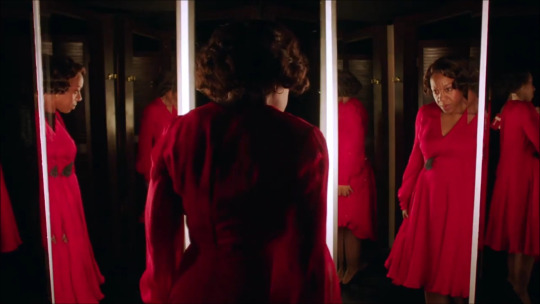
Based on the current reviews of In Fabric, I deem the film a poncy experimental spectacle. Not only did it not say much, but what it was trying to say was rather disturbing and quite frankly bizarre. However, it's not a film I can necessarily hate on as it is experimental, meaning from the get go, I shouldn’t be expecting any sort of clear cut narrative, with relationships, protagonists, conflict or hierarchies. Experimental films are more about exploring a central idea and having all its “characters'' not essentially prove the idea, but just talk about it, like a debate but everyone agrees in the end. A debate where everyone agrees would be boring, which is why I find experimental films to be boring as most of the time they don’t have a meaning and sadly as humans, we’re obsessed with finding the meaning of things or else we’ll go crazy. And I would say this film definitely left me crazy at the end, proving the idea of man’s constant need to find meanings in things. In Fabric wasn’t really relatable, funny, clever or bold. It kinda just...was.
Score: 5/10
Delicatessen (1991) as seen on DVD

I love how the world likes to think that the American film market is the only film market when in actuality the French created the actual concept of cinema and the idea to project “movies” onto a large screen. With this has come a plethora of incredible movies from France that have gone onto to change the film industry forever. There’s a reason why the most prestigious and exclusive film festival in the entire world is held in the South of France and not LA. Jean-Pierre Jeunet is the auteur behind Amélie (2001) one of the most well known independent films ever to be made and before Amélie came Delicatessen. This film is Tim Burton meets Wes Anderson but in French and tells the story of a man working for a butcher and the crazy characters he meets in the same apartment as him. By the end it's clear that The Butcher is selling more than pork and beef down in his store and that the new tenant is due to be the next item on sale. I loved how weird and larger than life the characters were and the otherworldly set design used for this film. There were so many moments that are quite hard to explain the beauty of them and if you’ve seen Wes Anderson or Tim Burton’s work, you’ll notice the similarities between this film and their work, perhaps showing a french influence on the current American market.
Score: 10/10
Amélie (2001) as seen on DVD
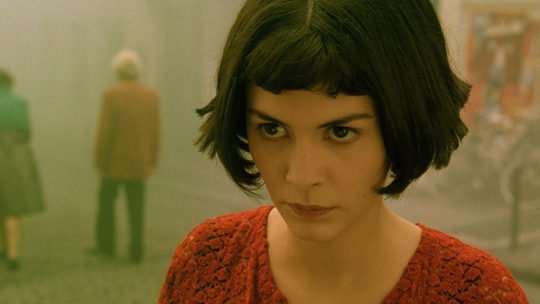
Continuing on with the French theme, I was reminded this month of the beauty of Amélie. Every, single, shot in this film is pure perfection and I bet all my money that Wes Anderson was a mega fan of this film when it came out. It's truly a film like none other and it’s only this time around did I realise how much I RELATE to Amélie. The way she sacrifices herself for others and gets nothing in return, the lengths she goes to tell someone something instead of JUST SAYING IT, her lack of friends, I can definitively say that there isn’t a character on screen that I’ve related to more than Amélie (besides Elio from cmbyn). If you haven’t seen Amélie have a word with yourself.
Score: 11/10
Pan’s Labyrinth (2006) as seen on Amazon Prime
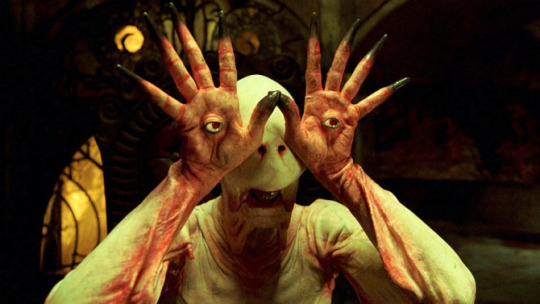
Pan’s Labyrinth was a surprisingly amazing film and I wonder why I hadn’t seen it sooner. I was astounded to see it was in Spanish which I thought made the story somehow better. It's rare that we see such high budget and well known film that’s in a foreign language but I’m glad this film got the noise it did when it was released. Guillermo del Toro (The Shape of Water 2017) tells us the story of 10 year old Ofelia and her discovery of magical creatures in the woods that inhabit the outskirts of her new home. Not only that but it’s 1944. The Spanish Civil War has been over for five years but small groups of guerrilla rebels continue to fight against the new fascist dictatorship led by Francisco Franco. This is a well structured film that shows two strong worlds and combines them in a satisfying way, which isn’t an easy thing as sometimes films can get lost in the facts of history instead of the emotions and dynamic relationships. The set design in this was UNREAL as always and I really felt for the characters and their given circumstances. And that’s what we call a film.
Score: 11/10
I Care A Lot (2021) as seen on Amazon Prime
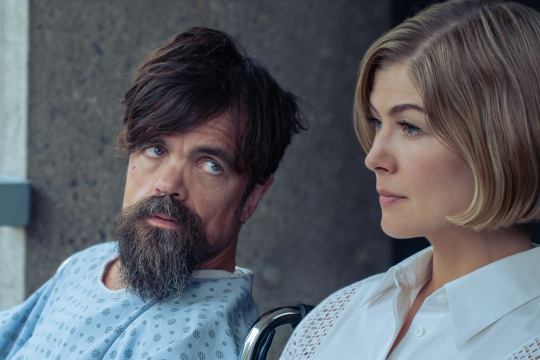
For a full review of I Care A Lot, follow the link: https://ratingtheframe.tumblr.com/post/643763403606867968/a-strong-performance-from-rosamund-pike-that-we
Score: 8/10
Interview with a Vampire (1994) as seen on BBC iPlayer
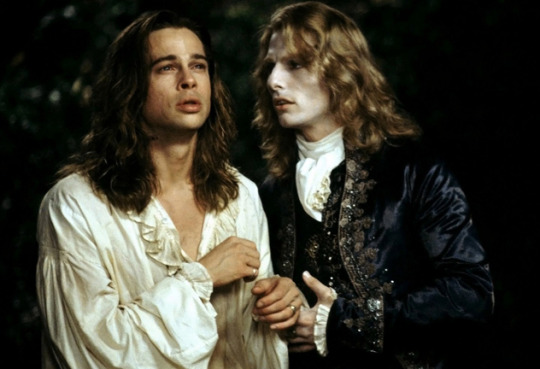
We were doing SO WELL until I made the costly decision to watch this waffle of a film, directed by Neil Jordan. Not only was the story all over the place, but the dialogue itself was incredibly on the nose and self explanatory throughout. It feels like there was more talking about the film instead of showing the film, which just made me switch off from early on in the film. I hated the casting of Tom Cruise in this and there were moments when I believed his character, but none of them outweighed the overarched and over bearing performance he was attempting to give. Brad Pitt was marginally better but the performance of Kirsten Dunst who was 12 years old at the time this film was released, outdid both actors. She was the only character that I truly felt for / cared about and her on screen presence was both enviable and wise beyond her years. Personally, I can’t explain what this film was even about because I truly didn’t get what was going on, however if you’re a fan of Kirsten Dunst’s work, this would be a suitable film to watch in that respect.
Score: 4/10
Fargo (1996) as seen on Amazon Prime

Fargo is probably most known as a Netflix series, but before that, it was originally a film directed by the Coen Brothers and starred the likes of Frances McDormand, Steve Buscemi, William H Macy and John Carroll Lynch. I’ve been meaning to watch Fargo for quite some time and I was not disappointed with the outcome of it. It's one of those good old fashioned crime films, with lots of twists and blood split throughout the film. The film won two Oscars in 1997; one for Best Actress which was handed to Frances McDormand playing a police officer investigating a string of murders in Minnesota and another for Best Original Screenplay. A really well constructed story with a fantastic cast and great cinematography work from Roger Deakins (1917 (2020), Blade Runner 2049 (2017) The Shawshank Redemption (1994).
Score: 10/10
The Darjeeling Limited (2007) as seen on Amazon Prime

The Darjeeling Limited further proves to us Wes Anderson’s ability to create entire new worlds and show us stories that take place all across the world. Three brothers, Peter (Adrien Brody), Jack (Jason Schwartzman) and Francis (Owen Wilson) have travelled to India in an attempt to bond with one another “spiritually” after the death of their father. Peter and Jack aren’t too keen on this little expedition, irritated at their brothers' intrusiveness over the trip. The majority of the film is set on this fanatical train travelling across India and yet again, we are blessed with some phenomenal production design to tell us a fun and uplifting story. What’s more is that the boys’ mother (Anjelica Huston) lives in India as a nun at the foot of the Himalayas. This becomes the real reason for their venture and such a thing changes the character dynamics between the three men. India is shown in all its beauty in this film using the backdrop of three men’s relationship with one another as a story.
Score: 9/10
The Life Aquatic of Steve Zissou (2004) as seen on DVD
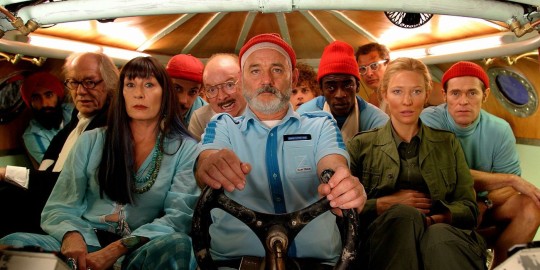
Another one of Wes Anderson’s lesser known films but equally as good as the rest, this film follows a group of marine explorers travelling across the pacific to try and kill a shark that supposedly ate a member of Steve Zissou (Bill Murray) ’s crew. With an all star cast composed of Bill Murray, Owen Wilson, Cate Blanchett, Jeff Goldblum and Anjelica Huston this film was entertaining, enlightening and cinematographically ambitious. Steve Zissou is a fictional character who makes a living off of extreme and dangerous marine explorations. He makes films of his travels using his crew and after screening his latest film, he meets a young man (Owen Wilson) claiming to be his son. Evidently, Zissou is reluctant to accept that this man is his son and uses his presence as financial gain to the project. I appreciated all performances in this film and the set design (as always with Anderson’s films) was exceptional.
Score: 9/10
Life of Pi (2012) as seen on Amazon Prime
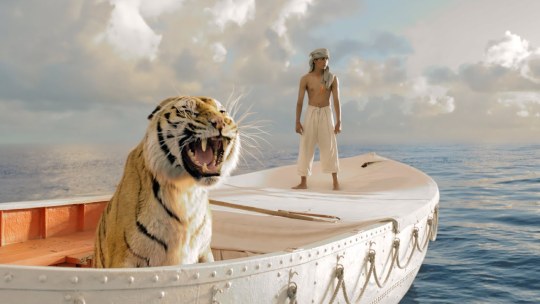
A highly visual and emotional film that carries beauty throughout in both performance and story, Life of Pi was directed by Brokeback Mountain (2005)’s Ang Lee and tells the story of Pi (Suraj Sharma and Irrfan Khan) a young boy alone in the middle of the Pacific Ocean with a fully grown Bengal Tiger. Winner of 4 Academy Awards including Best Director at the 2013 Academy Awards, this film does a phenomenal job of reminding us why cinema is such a superior and infinite art form. Pi’s family are on their way from India to America, exporting a large number of their zoo animals in hope of selling them once they reach the other side of the world. After a horrendous storm ravages their cargo ship, Pi is left all alone in the ocean with what only appears to be a small dingy, but to his horror, he comes to find that the zoo’s tiger Richard Parker is keeping him company in the middle of the ocean. Now if that ain’t a viable story, then I don’t know what is. To make a film look like it was set in the middle of a Pacific and with a Bengal Tiger is no small feat. Suraj Sharma’s performance was both truthful and powerful, despite the film being mostly shot in a studio with nothing but animation for Richard Parker. This is one of very few films that does the original novel justice.
Score: 11/10
Capone (2021) as seen on Netflix

Yikes. Capone has not been getting a lot of love in the media since its release on Netflix on 24th February. Personally, it's not the most god awful, offensive film I’ve seen and yet I wouldn’t have been the one to have made such a film either. The film is supposed to depict the last year of the infamous and notorious Al Capone, who suffered from numerous illnesses at only the age of 48. Tom Hardy plays the blood thirsty gangster and I have to say, this was a thoughtless casting choice. Hardy doesn’t have an ounce of Italian in his face and he put on this larger than life caricature of an accent that had me feeling rather sorry for him at moments when I shouldn’t have been. The acting was exceptional, but believable and interesting? That’s another argument altogether. Cinematography and sound wise, I thought the film was excellent in those respects but again, those should be additions to the integral story of a film. I get why Hardy signed up though, what actor wouldn’t want to play a mob boss? Maybe the point of Al’s life in which this film was built upon was perhaps wrong for the screen and I’m sure most would have preferred Hardy to play Capone at his peak. This film is a clear example of people getting ahead of themselves when they first explore an idea for a film. This film could have easily been saved in the development stage had someone said let’s not do this.
Score: 5/10
Creed II (2018) as seen on Amazon Prime
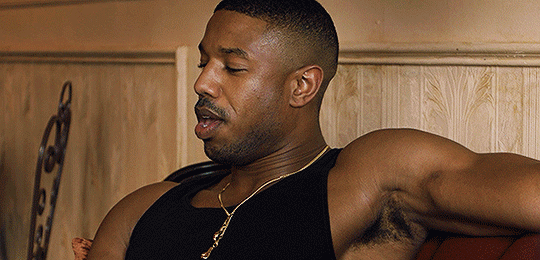
Obviously a prequel will always outdo a sequel, however I found Creed II to be just as meaningful as the first film. Maybe even more so as Adonis Creed (Michael B Jordan) is becoming a father his responsibilities have shifted dramatically. He’s also desperate to fight Viktor Drago, a Ukrainian ruthless boxer whose father accidentally killed Creed’s father in a match decades before. Drago is tough, beyond what he and his coach Rocky (Sylvester Stallone) could ever imagine and because of this, it drives a wedge between Adonis’ relationship with his coach. Creed thinks Rocky doesn’t believe he can beat Drago but Rocky insists not fighting the bull of a boxer would benefit him greatly, after all, look what happened to his father. The character dynamics have shifted in this sequel, but the structure has remained largely the same. We kind of knew what we were being served at the end and the change in character was there for everyone.
Score: 10/10
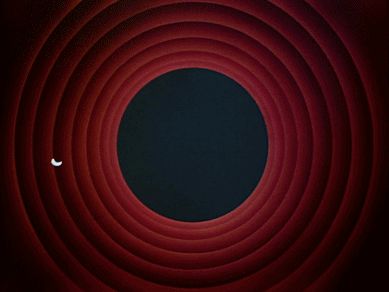
...and that’s it! Everything I watched this February, you do not want to KNOW how long this list took to compile. Thanks for reading and see you next month!
ig: @ratingtheframe
#Movie Reviews#new movies#movies#natalie portman#sci fi films#alex garland#netflix original#Netflix movies#netflix#fifty shades trilogy#malcolm & marie#zendaya#john david washington#sam levinson#euphoria#coming to america#do the right thing#spike lee#the life ahead#sophia loren#matthew maconaughey#creed#michael b jordan#arrival#denis villeneuve#the news of the world#tom hanks#the mask#jim carrey#cameron diaz
22 notes
·
View notes
Text
NaNo Prep Week #3 - Construct a Detailed Plot or Outline
NaNo Prep is a series of blog posts covering the NaNo Prep 101 curriculum which is a good outline of the things you want to do to get ready for NaNoWriMo, or National Novel Writing Month.
We’re into Week #3 now we’re looking at plot.
Resources
I would start here with Brandon Sanderson’s Lectures, Plot Part 1, Plot Part 2, and the Plot Q&A and Viewpoint. These effectively frame the elements of plot and plotting you want to look at. Don’t skip the section on viewpoint at the end of lecture three as its incredibly useful. With this as the starting point, the remaining sections are divided into Outlining, Plot Structures and Plot Archetypes.
Outlining
11 Steps to a Complete Cozy Mystery Plot from Jane Kalmes is a rare example of showing the outlining process in progress. I found another in a series of videos by Chris Fox called How to Plot a Novel From Scratch, but Janes has more re-usable structure. That being said, Chris seems to have another playlist that might be more structured, I just didn’t have time to watch that one too.
You can see the example outline to a Brandon Sanderson novel, Skyward, here as well as two failed attempts.
You can use any of the plot outlines as a framework for outlining your plot. Outlining is typically more than just the plot - it includes character and worldbuilding and, despite the artificial separation of these three, they actually bounce off one another a lot. The Jane Kalmes and Chris Fox examples show this.
Plot Structures
There are so many of these. Sanderson covers two of them in his lectures - the Heroes Journey and the Three Act Structure and videos on these are everywhere. Some examples: 3 Act Story Structure for Authors from Alexa Donne, 15 Beat Plot Structure from ShaelinWrites
Dan Well’s 7 point plot structure is based on the Star Trek RPG Narrator’s Guide and gets its own mention because of the RPG reference.
Katytastic’s 27 point plot structure, which is probably my favourite.
Adding to the above is the ever popular Save the Cat (which is also a three act structure). The main headings for Save the Cat appear in the Jane Kalmes video or you can google for a wealth of other material on this one. I have the book Save the Cat Writes a Novel, but you can find everything in it on Youtube.
For those who want a physical outlining method, I did like E A Deverell’s Plot Structure Zine. There is a video showing it in action on this page, as well as non-video based instructions. This gives you an 8 point story structure.
Plot Archetype
This as a concept is less spoken about and probably the main resource for this is Writing Excuses Season 11 on Elemental Genre. I did find a couple of books and an experiment where an AI ingested stories from Project Gutenberg. I also found quite a range in the number of plot archetypes from 3 to 1,462… A good summary of the 7 Story Types can be found in a this Reedsy video from Shaelin, but I didn’t find it useful for helping me plot my story in the way the Writing Excuses episodes do.
Another thing I do, that I think is similar in hindsight, is look at the website TV Tropes. Go there and look up a supertrope and you will find it broken down into sub-tropes and the myriad small tropes that make up a larger trope. These give you the building blocks of Plot Archetypes, including things that are more specific like Cosmic Horror. The website gives you lists of the component parts and, most usefully, long lists of the trope in various types of media to give you examples for further research.
How I Used Them
First I had a little crisis. In quite a few of the videos above, the authors talk about letting the plot develop in their heads over time. I’ve had the idea for the plot I am currently looking at for a grand total of 3 weeks, as opposed to the months experienced authors seemed to spend. Should I go forward with the new story or should I pick up something I’ve developed for longer?
Once I got past that, I tried a lot of different outlining methods. In the end I landed with the following:
Lots of brainstorming with no real structure giving me a very short outline of the main characters and themes. I iterated on it, writing it a couple of times. I liked the main plot, but it didn’t feel substantial enough. So I added a serial killer! It did fall logically out of the work I was doing, especially the worldbuilding. When trying to lay out the purpose of a group, it became obvious someone needed to be doing something proactive to achieve their goals. The killer is trying to prevent a terrible outcome by killing the people who would make it happen.
I then ran all the major plot threads through different approaches and found the ones I liked best.
Using Dan Well’s approach, at least in terms of order, was incredibly useful. I am so glad the Star Trek RPG references made me watch those videos. It gave me a very broad overview which I didn’t feel was enough to be my end product, but it really helped shape that end product.
I then wrote a plot outline much like the Brandon Sanderson approach, but with the following modifications:
Each major/side character had a listed set of “state transitions of Beginning, Middle and End, taken from the 7 point outline I had used.
I had a mapping underneath the plot bullet points that used the 27 point story structure from Katytastic against the main plot threads. This created a nice grid showing me where different things happened in the story. I numbered the plot bullets and referenced them in this grid too.
What I didn’t have time to do (because its barely Sunday when I write this, and I do try to post on Sundays) was to explore the plot archetypes more and I will do this over the next week. I’d like to look at each major thread, decide what its archetype is and look at those archetypes to see if there is anything I should add. For example, Sanderson mentions that a buddy cop plot is essentially a romance and since my lead characters are going to have that storyline, I want to see if I can learn anything from the archetype to enrich it.
4 notes
·
View notes
Note
Would love to hear about your beefs with Lucas because I have beefs with Lucas
(Sorry it took me three thousand years to answer this, anon.)
They mainly fall under a few headings, with the third being the most serious and the thing that I am genuinely irl furious about at least biannually (and feeling unable to adequately sum up The Problem with it after yelling about it so often is a huge part of why this post has been in my drafts for such a long time):
1. His self-mythologising and the subsequent uncritical repetition of his bullshit in the fandom. Obvious lies like that he had some master plan for 10 films when it’s clear he did not have anything like a plot outline at any point. We all know the thing was written at the seat of various people’s pants, it’s blatantly self-evident that’s the case. There’s also plenty of public record about how the OT was written. Even dumber, more obvious lies, like that Anakin was ‘always the protagonist’ and the entire 6 films were his story from the beginning. This is preposterous and every time someone brings it up (usually with palpable smugness) as fanboys ‘not understanding star wars’ because they don't get that ‘the OT is not Luke's story’... Yeah, I just... I cannot.
Vader wasn’t Anakin Skywalker until ESB, it’s a retcon. It’s a brilliant retcon and it works perfectly, it elevated SW into something timeless and special it otherwise would not have been, but you can tell it wasn’t the original plan and there’s proof it wasn’t the original plan. Let’s not pretend. And Luke is the protagonist. No amount of waffling about such esoteric flights of theory as ‘ring structure’ is going to get away from the rigidly orthodox narrative and the indisputable fact that it is Luke’s hero’s journey. Vader’s redemption isn’t about his character development (he has almost none) and has no basis in any kind of convincing psychological reality for his character, but it doesn’t need to be because it’s part of Luke’s arc, because Vader is entirely a foil in Luke’s story. It’s a coming-of-age myth about confronting and growing beyond the father.
All attempts to de-centre Luke in RotJ just break the OT’s narrative logic. It’s a character-driven story and the character driving is Luke. Trying to read it as Anakin’s victory, the moral culmination of his choices rather than Luke’s and putting all the agency into Anakin’s hands just destroys the trilogy’s coherence and ignores most of its content in favour of appropriating a handful of scenes into an arc existing only in the prequels. The dilemma of RotJ is how Luke will define ethical adulthood after learning and growing through two previous films worth of challenge, education, failure, and triumph; it’s his choice to love his father and throw down his sword which answers the question the entire story has been asking. Vader’s redemption and the restoration of the galaxy are the consequences of that choice which tell us what kind of world we’re in, but the major dramatic conflict was resolved by Luke’s decision not the response to it.
And, just all over, the idea of Lucas as an infallible auteur is inaccurate and annoying to me. Obviously he’s a tremendous creative force and we wouldn’t have sw without him, but he didn’t create it alone or out of whole cloth. The OT was a very collaborative effort and that’s why it’s what it is and the prequels are what they are. Speaking of which.
2. The hubris of the prequels in general and all the damage their many terrible, protected-from-editors choices do to the symbolic fabric of the sw universe. Midicholrians, Yoda fighting with a lightsabre, Obi-wan as Anakin's surrogate father instead of his peer, incoherent and unmotivated character arcs, the laundry list of serious and meaningful continuity errors, the bad storytelling, the bad direction, the bad characterisation, the shallowness of the parallels which undermine the OT’s imagery, the very clumsy and contradictory way the A/P romance was handled, the weird attitude to romance in general, it goeth on. I don’t want to re-litigate the entire PT here and I’m not going to, but they are both bad as films and bad as prequels. The main idea of them, to add Anakin’s pov and create an actual arc for him as well as to flesh out the themes of compassion and redemption, was totally appropriate. The concept works as a narrative unit, there are lots of powerful thematic elements they introduce, they have a lot of cool building blocks, it’s only in execution and detail that they do a bunch of irreparable harm.
But the constant refrain that only ageing fanboys don’t like them and they only don’t like them because of their themes or because they humanise Anakin... can we not. The shoddy film making in the prequels is an objective fact. If you want to overlook the bad parts for the good or prioritise ideas over technique, that’s fine, but don’t sit here and tell me they’re masterworks of cinema there can be no valid reason to criticise. I was the exact right age for them when I saw them, I am fully on board with the fairy tale nature of sw, I am fully on board with humanising Anakin- the prequels just have a lot of very big problems with a) their scripts and b) their direction, especially of dialogue scenes. If Lucas had acknowledged his limitations like he did back in the day instead of believing his own press, he could have again had the help he obviously needed instead of embarrassing himself.
3. Killing and suppressing the original original trilogy. I consider the fact that the actual original films are not currently available in any form, have never been available in an archival format, and have not been presented in acceptable quality since the VHS release a very troubling case study in the problems of corporate-owned art. LF seizing prints of the films whenever they are shown, destroying the in-camera negatives to make the special editions with no plans to restore them, and doing all in the company’s considerable power to suppress the original versions is something I consider an act of cultural vandalism. The OT defined a whole generation of Hollywood. It had a global impact on popular entertainment. ANH is considered so historically significant it was one of the first films added to the US Library of Congress (Lucas refused to provide even them with a print of the theatrical release, so they made their own viewable scan from the 70s copyright submission).
The fact that the films which made that impact cannot be legally accessed by the public is offensive to me. The fact that Lucas has seen fit to dub over or composite out entire performances (deleting certain actors from the films), to dramatically alter the composition of shots chosen by the original directors, to radically change the entire stylistic tone by completely reinventing the films’ colour timing in attempt to make them match the plasticy palate of the prequels, to shoot new scenes for movies he DID NOT DIRECT, add entire sequences or re-edit existing sequences to the point of being unrecognisable etc. etc. is NOT OKAY WITH ME when he insists that his versions be the ONLY ones available.
I’m okay with the Special Editions existing, though I think they’re mostly... not good... but I’m not okay with them replacing the original films. And all people can say is ‘well, they’re his movies’.
Lucas may have clear legal ownership in the capitalistic sense, but in no way does he have clear artistic ownership. Forget the fans, I’m not one of those people who argue the fans are owed something: A film is always a collaborative exercise and almost never can it be said that the end product is the ultimate responsibility and possession of one person. Even the auteur directors aren't the sole creative vision, even a triple threat like Orson Welles still had cinematographers and production designers, etc. Hundreds of artists work on films. Neither a writer nor a director (nor one person who is both) is The Artist behind a film the way a novelist is The Artist behind a novel. And Lucas did NOT write the screenplays for or direct ESB or RotJ. So in what sense does he have a moral right to alter those films from what the people primarily involved in making them deemed the final product? In what sense would he have the right to make a years-later revision the ONLY version even if he WERE the director?
Then you get into the issue of the immeasurable cultural impact those films had in their original form and the imperative to preserve something that is defining to the history of film and the state of the zeitgeist. I don't think there is any ‘fan entitlement’ involved in saying the originals belonged to the world after being part of its consciousness for decades and it is doing violence to the artistic record to try to erase the films which actually occupied that space. It's exactly like trying to replace every copy of It's a Wonderful Life with a colourised version (well, it's worse but still), and that was something Lucas himself railed against. It’s like if Michaelangelo were miraculously resuscitated and he decided to repaint the Sistine Ceiling to add a gunfight and change his style to something contemporary.
I get genuinely very upset at the cold reality that generations of people are watching sw for the first time and it’s the fucking SE-except-worse they’re seeing. And as fewer people keep physical media and the US corporate oligarchy continues to perform censorship and rewrite history on its streaming services unchecked by any kind of public welfare concerns, you’ll see more and more ‘real Mandela effect’ type shit where the cultural record has suddenly ‘always’ been in line with whatever they want it to be just now. And US media continues to infect us all with its insidious ubiquity. I think misrepresenting and censoring the past is an objectively bad thing and we can’t learn from things we pretend never happened, but apparently not many people are worried about handing the keys to our collective experience to Disney and Amazon.
4. The ‘Jedi don’t marry’ thing and how he wanted this to continue with Luke post-RotJ, so it’s obviously not meant to be part of what was wrong with the order in the prequels. I find this... incoherent on a storytelling level. The moral of the anidala story then indeed becomes just plain ‘romantic love is bad and will make you crazy’, rather than the charitable reading of the prequels which I ascribe to, which is that the problem isn’t Anakin’s love for Padmé, it’s that he ceased to love her and began to covet her. And I can’t help but feel this attitude is maybe an expression of GL’s issues with women following his divorce. I don’t remember if there’s evidence to contradict that take, since it’s been some time since I read about this but yeah. ANH absolutely does sow seeds for possible Luke/Leia development and GL was still married while working on that film. Subsequently he was dead set against Luke ever having a relationship and decided Jedi could not marry. Coincidence?
There’s a lot of blinking red ‘issues with women’ warning signs all over Lucas’s work, but the prequels are really... egregious.
#sw#salt#more unhinged rambling#anyway dowload the despecialised editions#unsubscribe from Disney+#be free#usually we'd be having a big family thing for Boxing Day but you know#so God bless us all at home separately#I hope everyone had as happy a Christmas as possible in keeping with the situation#I should see if I can drag my brother outside to build a snowman
42 notes
·
View notes
Text
Dracula BBC as an alchemical novel
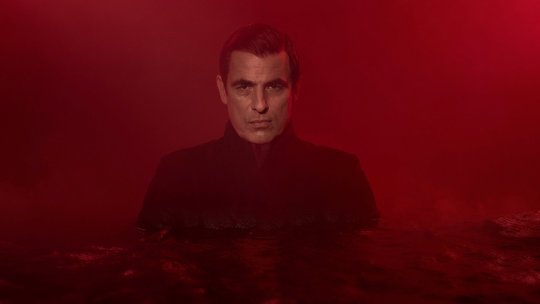
I noticed a long time ago that the stories that S. Moffat and M. Gatiss tell do not just have two or three layers (in fact, much more), but most often turn out to be such a complex field in which all the numerous levels work independently and at the same time manage to merge into a holistic melody. Actually, this is why their texts often ‘from the outside’ look strange, incomprehensible or meaningless (apart from those cases when they really are like this).
The thing is that stories of this kind are arranged in such a way that the plot, as a frame, ‘holding’ ideas and meanings on itself, is, so to speak, open — like a system of corridors leading in different directions, up and down, into those dimensions of the narrative that are currently needed by the authors in order to convey their statement.
In this respect, the genre is very important, because by structuring the story at the formal level, it allows, let’s say, to enter it and understand where to move from the entrance. And there — well, depending on how far you are willing to go.
One of the best definitions of the Dracula genre that I have seen among the reviews written so far is a metaphysical detective.
Some might say that the term looks artificial, but bearing in mind that the story itself seems to be enough… hybrid, it would be fine to start a conversation.
This really has everything a good detective novel needs, plus philosophical and (almost) religious motives organically woven into the narrative, the idea of self-knowledge that pushes the boundaries of any genre, and a mysterious ending. So it’s easy to agree with the above definition.
But I would say that this is an alchemical novel.
Let me remind those who have not come across the works of C.G. Jung, who in his later work paid much attention to alchemy and secret religious practices: in the context of his research, alchemy is a way of self-knowledge and one’s own psyche in order to achieve a higher level of development and gaining mental and spiritual integrity.
History of literature knows several rather interesting attempts to describe the alchemical Work and, since cinema in this sense is no worse, if you wish, you can immediately name a dozen films that also touch on this topic. Well, Sherlock, being viewed from a certain angle quite fits into this paradigm, and I will not even start about Harry Potter — this is a classic of Jungian thought, expressed in literature and successfully transferred to the cinema.
What about Dracula? Everything is very interesting in it.
The first thing to note is that Dracula’s structure is not a mini-series. It’s not a TV show at all. This is a three-part film, all parts of which are closely related to each other so that none of them can be ‘taken out’ from the text without losing meaning and understanding what is happening here.
The second, — it is undoubtedly a novel. The novel as a genre has many definitions, I will not give them here, I will only mention an element that is important for our conversation, without which a modern novel is impossible. This is the growing up and inner change of the hero. If the hero came to the end of the work, being not the same he was at the beginning, most likely we have a novel. Another question is how the hero came to these changes.
And here the third aspect is important — the way the story is told and the ‘language’ used by the authors.
Act I
Dracula begins with a young man standing in the middle of a dark forest and waiting for a carriage that will take him to the medieval castle of some mysterious Count. A girl comes out of the carriage in which the young man reached this place, and asks him to take the crucifix with him, assuring him that he will certainly need it. The carriage leaves, the young man remains in the forest.
Look, you can ‘exit’ from this scene both into a gothic novel (in principle, an entertainment genre, to which you can add a couple of additional meanings if you wish) and into an alchemical story. The exposition will be the same. Let’s suppose we are talking about an alchemical novel. For now, just suppose.
Dark forest is a place between worlds, between everyday life and the other world, between consciousness and unconsciousness, between daytime reality and nighttime. Place of transition, no one’s land. The laws of consciousness are no longer dominant here, but the unconscious does not yet dominate. You can also talk with those who live in the real world and get from them the so-called ‘magic item’, which may help the hero in the future, but it is already difficult to return. And — what is important — you can only travel further with a guide from the unconscious. Carriages from the outside world don’t go there.
The young man is picked up by a strange cart with a mysterious charioteer, after which, having driven some distance through the forest, he finds himself at the gates of an ancient castle. Going inside, he sees an empty room and a table set for dinner. This is the second point of transition if you follow the logic of archetypal storytelling. While Johnny is nothing more than a guest, a stranger, a man who has nothing to do with this castle or its inhabitants. He crossed the border of the unconscious but did not enter into a relationship with it. And here he does what the fairy tales strongly advise against doing to everyone who finds himself in such circumstances — he tries local food.
The game is on. From that moment — not from the first bite, but from this moment, Johnny enters the reality of Dracula, the reality of his castle, and begins to interact with forces that are incomprehensible and beyond his control.
But this is not the most interesting thing.
Let’s skip the moment of the Count`s appearance — here the authors again make a nod to the gothic novel, and the whole situation logically unfolds like an old horror movie, exactly until the moment when several new details appear in the narrative.
The first is the invisible inhabitants of the castle, who write on the glass with inverted letters ‘save us’, and the second is a journey through the castle-labyrinth and the discovery of the map.
Remember I said that this story could be a gothic novel, and the plot is quite like a gothic novel? So, forget it. From now, there is no way to return to this genre. The gothic novel is about controlled horror. It’s about tickling your nerves in a safe environment. In this form, it moved into the cinema and settled there in the form of horror films. It has no other functions and building blocks. Moreover, the symbolic details. The scary house there is always just a scary house, and the worms crawl out of the walking dead because it looks disgusting, and the viewers love the thrill.
But let’s back to Dracula.
Why are the castle-labyrinth and map important? On a metaphorical level, the house represents a person, that Self that a person knows, ‘builds’ throughout life and which belongs to it. A castle-labyrinth in which it is easy to get lost, which does not have a map, indicates a lost person.
And it was not Johnny who was here lost.
Have you ever thought about why, after being sucked dry and killed, the lawyer threw himself from the roof of the castle and was fished out of the river by fishermen, Dracula did not leave him alone and went to the convent after him?
What does this ‘bride’ mean to him, in no use as a food, dagger stares and pursed lips, and even threatens to fight Dracula while walking on the ground? Although it is doubtful he could fight — he could barely keep his feet.
Pride? Wounded amour-propre? A sense of ownership?
No.
In order to understand why Dracula came for Johnny, you need to return to the search for the map and remember where Harker found it.
In the depths of one of the corridors of the castle hung two portraits — the image of the architect who built the house and his wife. About which ones the architect himself refers in his notes as the Moon and the Sun.
It is noteworthy that a woman is the Sun here, while in the alchemical tradition, the solar energy is male, and the lunar energy is female. I think this is part of the inverted reality of the Count`s psyche, where landmarks are confused and roles are changed. For what it’s worth, such landmarks are enough for Harker to find a way out.
But it’s important for us to understand who Johnny is.
He is not a victim of Count Dracula. Rather, from the point of view of the plot, he is his victim, but at the symbolic level, his function is completely different.
Jonathan Harker is a figure from the outside world who comes to the house of a person whose psyche is immersed in chaos, who himself does not know what is in his house, and is able to get lost in it himself, keeps monsters in the basement and feeds on them. This person has lost touch with reality in the literal sense of the word. (For anyone interested, read about literalized metaphors in British literature.) And then someone comes to him, and involuntarily begins to order his chaotic world.
It is no coincidence that during one of his conversations with the Count Johnny hears a crying baby. At the level of the plot, this is a real baby that Dracula carries for his next ‘bride’ imprisoned in the basement of the castle. But at the symbolic level, where all the inhabitants of the castle are parts of the soul of the Count himself, the baby is his split-off child self. Of course, destined for murder. And turned into a child of the night.
What happens next? At the moment when the process of ordering the psyche and contact with the outside world is launched, it is already difficult to stop it. Therefore, Dracula with a manic passion rushes to the convent and tries to regain Johnny. But the function of the guide has been exhausted. Other forces come into play.
Act II
The central scene of what is happening in the convent is undoubtedly the scene of the meeting between Dracula and Agatha. And in their meeting, everything is important, literally every detail. Strikingly, it is harmoniously built both on the plot and on the symbolic level. There is literally no redundant element there.
We will only note the main ones so as not to get bogged down in details.
The first moment — Dracula went out into the outside world, but he cannot just appear there. Until now, his whole life has passed in darkness — both literally and symbolically. We do not know what made him so, but he obviously at some point in his life fell back to animal, primitive instincts. Therefore, in order to leave his world and exist in the real, in the world of consciousness, he needs to transform.
This is the first transformation of the hero that we see — when at the gates of the monastery Dracula is ‘born’ from the skin of a beast.
Having been born, he approaches the gates, which are opened to him by a genuine, not escheat, and fake bride — Agatha. Anima.
And she doesn’t give him any indulgences.
In Jungian literature, it is often mentioned that meeting with an archetype is a difficult and rather painful thing. Especially if the person is not ready for it. And, of course, it is extremely dangerous to project archetypal qualities onto a real person who can represent them for a specific man or woman. But this is in life. And a work of art`s entitled to combine symbolic and real layers in one context.
Agatha treats Dracula harshly, in a semblance of an erotic scene, giving an outlet for his insane disordered sexual and animal energy, in some way, ‘shaking’ him and allowing his inner chaos to restructure and acquire a consistency suitable for connecting with the new and the unknown.
And then the victim, close contact, an attempt to absorb — and the hero falls into his Anima and at the same time goes to a new world on a journey on the water.
Act III
I think that the symbolism of water (amniotic fluid, the water of the unconscious, water as an information and life medium) is not worth explaining. But what is happening with Dracula in the sealed world of the mother’s womb — the ship, in order for no one to have any doubts, called Demeter, needs to be considered more closely.
From this moment, from the moment when his romance with Agatha starts and begins to develop, Dracula’s relations with other people become extremely important. Until now, he had no relationships with people. The ‘brides’ in the castle are nothing more than food and separate parts of his own personality. The first person he established a real relationship with was Johnny. And this — on one of the levels — is another reason why Dracula was so attached to him. You never forget first love.
On Demeter, the Count consecutively comes into contact with several people.
What kind of people they are is very important.
The first is still just a victim. A sailor-helmsman, whom Dracula eats only because he needs a specific quality that the man has. This is how children are friends with those from whom you can ask for a useful thing or write off homework. After the object’s function is completed, the friendship ends.
It’s more difficult with the Grand Duchess. This is a story about memory, desire, and youth, Dracula`s question to himself — can I be liked, and if I can, then why: because my appearance evokes memories of youth or because I am interesting on my own? The dance as part of their interaction indicates an attempt to ‘taste’ the relationship (the Anima looks in-depth with a smile) but turns into a bloodbath.
What is important here is that as the ship sails further into the sea, and the relationship between Dracula and Agatha becomes more and more intimate, the Count begins to get more and more nervous, and his instincts, at first completely tamed for a distant goal, become more and more out of control.
He collected these passengers in advance, calculating how many people he needed to eat in order to safely get to England. And in the first two days, he ate half of them. The tension rises, the anxiety elevates, no one is safe. Including Dracula.
The meeting with Dorabella on deck (I just want to say — ‘date’) is a naive attempt to flirt, a conscious — not a vampire’s natural — desire to please, a short, but independently built with great difficulty dialogue. The portrayal of her possible married life shown to the girl is a gift that is discouraging in its brutality. And the conclusion: no, nothing will come of it. ‘I am a vampire.’
But if you have already gone out into the outside world, do not expect that you will be able to hide. Whatever you think, but you have made your choice.
After the murder of Dorabella, the ship literally ‘boils’, the hidden truth comes to the surface in the literal sense, and Agatha reappears on the scene.
Act IV
Many viewers ask: why did Agatha take command of the ship?
And who else should be the captain of the ship called Demeter under these circumstances?
Falcons give way to turtle doves.
But let’s back to the text.
The confrontation-connection of Dracula and his Anima lasts for some time, after which it logically ends with immersion of both in water.
And here is another interesting point. The first part of the alchemical Work is completed, the hero went through two transformations, began to communicate with living people, and even made some progress, but in order to consolidate the result, the psyche must close off from the world and allow deep processes to take place inside. Therefore, Dracula falls asleep at the bottom for 123 years, and Agatha fell off the map.
In the XXI century, the updated Count discovers that everything has changed, but the hunt for vampires is still relevant, and he himself is quite ready for new achievements.
The trouble is that he has already learned the taste of the genuine, and therefore surrogates are not to his liking.
When I watched the film for the first and second time, I just couldn’t understand why Lucy was needed there. Silly, superficial, narcissistic, she has no interest in anything other than herself and her Instagram images.
‘How could such a girl interest Dracula?!’ viewers around the world yell. And they are right.
How indeed?
Well, she couldn't.
In order to understand what Lucy’s role in this story is, you need to watch the film from the very beginning. Then it becomes clear that Dracula’s relationship with her, their dialogues, interaction, jokes and flirting, her willingness to voluntarily let him drink her blood is a complete parallel, a repetition of the Count’s relationship with Agatha. Having found the experience of deep love within himself and has found a connection with his soul, the hero is desperately trying to reproduce it — and fails.
Review these scenes. How he looks at Lucy, how he walks arm in arm with her, how he tells her what a brave and extraordinary girl she is, how he holds her on his lap, and asks where she wants to go. In fact, he does everything he did with Agatha. But doing all this, he has empty eyes. An indifferent look, mechanical movements, and bitterness at the bottom. He has a young beautiful woman in his arms, she is obviously in love with him, although she hides it, she is ready for anything to make him feel good. And he is bored.
In the eyes turned to Lucy, not the greed of a vampire is — there are darkness, sadness, and endless repetition: ‘Not her, not her, not her.’
But the psyche, especially the psyche of an adult, does not simply abandon its habits, so Dracula repeats with Lucy the entire cycle that has already passed with all his ‘brides’. The catch is that Lucy is not attached to him, but to admiration for her own beauty, and when beauty disappears, their illusory connection falls apart, turning into horror and contempt. But here, too, not everything is so simple.
In the scene in Dracula’s house, where Lucy realizes who she has become, an important parallel arises.
Look. There are four characters in the room. The situation is difficult, tense, the conflict reaches its limit until it is resolved through love. But how is it resolved?
I mean, what does it look like structurally?
It’s very simple. The man and the ‘monster’ stand and watch the kissing of the man and the ‘monster’ next to them.
And then something happens not only with Jack and Lucy, who finally managed to find peace but also with Dracula. This is the highest point from which there is only one path — to catharsis. The fact that Agatha led him there is logical and obvious, but up to this point, he was not ready for it.
And the final scene. When all the pieces are on the board, all conflicts are realized and all the ghosts are brought to light, there are no enemies left. Except for himself. Except for that, which he didn’t allow himself to do. Except for the fear of being yourself.
The ending of this film is the pinnacle of the alchemical process. Transformation. At the level of the plot, physical death, freeing a five-hundred-year-old vampire and a woman who loved him for many years. And at the symbolic level — going beyond one’s own limits and gaining integrity.
Therefore, in the final, we see the sun. The sun is a symbol of a purified consciousness, transformed and fully realized itself.
Epilogue
For those to whom the interpretation that I have presented here seems strange or stretch, I will separately note the following. Any interpretation is, to one degree or another, a figment of the imagination of the viewer or reader, although, unlike postmodern literary scholars, I believe that there are right and wrong interpretations. And the correct interpretation is not at all what the author wanted to say. This is what the story wanted to say. Often they are not the same thing.
And the second, closely related to the first: no, I do not think that S. Moffat and M. Gatiss put such meaning in their story. I think that European culture, with its multi-layered nature and the ability to reflect on complex experiences through symbolic stories, is that powerful semantic field that generates such tales regardless of the wishes of screenwriters and writers. And that seems wonderful to me.
19 notes
·
View notes
Note
The nerve of them saying "Sansa stans make everything in the story about her" when they think 1) Arya is currently Lady of Winterfell. (They use it to justify her killing of Dareon, "iT's JuSt LiKe NeD eXeCuTiNg tHaT DeSeRtEr" no Karen it's not, Arya is not LOW and she had no right to be judge jury and executioner) 2) Arya will be crowned by LSH in Riverlands. 3) She will have a key role in the fight against Others. 4) Arya might also rescue free folk from Hardhome. 5) Arya will kill Ramsay. (while wearing Jeyne's face, in some version of this theory) ??? Like what?? 6) She'll marry the guy of her dreams, become Lady/Queen and will pop out many children. (Not to mention the recent trend of giving Sansa's attributes and things connected to Sansa's arc to Arya and claiming they belong to Arya and only Arya: motherhood, femininity, romance, dancing (yes they said that too, remember she has a "dance master", ruling/political arc etc)
Even if they don't think ALL of them will happen, to theorize ALL of these things for one character is ridiculous. These are all separate arcs, they have different themes and narrative weight. It just shows how they think Arya belongs in everyone's arc, she should have everything, she can do everything, be everyone. To them Arya is not a full-fledged character with her own arc, her own agency but an empty vessel they project onto.
Hi there!
Allow me to drop similar asks here as well:
The way Arya stans feel threatened by Sansa/Lyanna parallels is very telling ... We never said Sansa was Lyanna 2.0 and we never said Sansa likes horseriding or fighting with a sword, but her story parallles Lyanna's a lot. So we don't need to "twist" Sansa's character (like Arya stans do to make Arya more feminine, maternal etc..), because Sansa and Lyanna's parallels aren't in personalities but in themes and plotlines. We just point out those similarities, and there are a lot! And isn't it a tad bit hypocritic of Arya stans to act like we twist Sansa's or Lyanna's characters, which we don't, when they themselves make Arya seem like Alysanne solely on the basis of one similarity, of Alysanne liking hunting and archery? While ignoring all of Alysanne's personality: sweet, gentle, courteous, charming, pleasing, she could read before she could walk, and she was not willful like a certain Aerea. (Who is called sweet many times? Sansa. Who had a gentle soul? Sansa. Who considers courtesy her armour? Sansa. Whose name means charm? Sansa. Who was eager to please? Sansa. Who could read and write better than her brothers? Sansa. Who was not willful like a certain Arya? Sansa. Duh!)
I totally get the "we don't hate Sansa but the stans' attitude" thing. It very clearly translates to: "we like Sansa when she is kept in her lane and we get mental breakdowns when her stans draw her parallels with other characters as a way of literary analysis because it 'elevates' her and makes her important, which we can't stand. Also, she is so uninteresting we talk about her all the time."
Arya stans should watch Cinderella and read YA novels where they the average-but-actually-very-beautiful-abused-girl can triumph over their middle school bully the mean girl.
First of all: Let my say thank you for all the support. Antis have been flooding Sansa /Jonsa blogs inboxes for days now and it is always nice to see that we have each others’ back.
So, thank you again, but to be quite honest, I am not very bothered. Because their attempts at jinxing the “Sansa will be Queen” narrative by dropping hateful asks in our inbox won’t have any effect.
Because it is not them who write the books. And let’s be quite real, if they would write the book it would be incredibly boring, because it would be the tale of the “not like other girls” - ugly duck becoming the “opps, actually beautiful, feminine and caring” - swan.
There is an ugly word for what they do with Arya: Mary Sue. I don’t like that word very much, because I think people have a right to dream a story for themselves where they are the actual heroine that can do nothing wrong and gets it all in the end. People should be allowed to indulge in tales like that, if they want to.
But other people are also allowed to not be particularly thrilled by an ultimately boring narrative like that. It dissolves all character traits (that let me fall in love with the character at first) and makes the character a projection that everybody can project onto.
There are fics that have Sansa as a fighter, learning the sword and all that, very ooc and all. But these are fics. Anything can be done in fics and it’s not my jam, but let people enjoy this.
But I have yet to see a Sansa analysis, that ascribes her character traits she does not have or wishes for her to be a knight, fighter, lady, beautiful, Queen, clever, learned, cunning, maternal, caring and all of that together. If we talk about parallels Sansa has with other characters, we don’t assume that she will suddenly a) become that character and b) has all the characteristics of said character. Sometimes the parallels are characteristics, sometimes they are story arcs or even part of story arcs.
Arya can look like Lyanna, wield the sword like Lyanna and still might not share other characteristics with her aunt (which is how real life is, if I look at my own nieces and nephews!)
Actually, I loved Arya from the beginning, and yes I loved her for the “Not like other girls”, because she was chafing at the restrictions of her society, reminded me very much of myself, and it is clear, that at least BookArya does not look down on other girls or women. She tries to find her way and I honestly believe that she might end up more feminine than she started, especially if her learning ‘Mercy’ will come to pass.
But Arya is not the main character, and neither is Sansa, nor Jon, nor Bran nor any of the others.
The really beautiful thing about ASOIAF is that the cast plays together. There is no single hero or heroine. I am convinced that the “pack survives” will mean that each will have a role to play and in the end the puzzle pieces will fit, and we can say: Thank God, Arya did that back in book 3 or, OMG I would never have thought that Jon doint this in book 1 would have such an impact or Wow, Sansa really pulled that of and it was good she did, because otherwise they all would have been dead.
I imagine something a bit more sophisticated than LotR, where the Fellowship works together for the main goal with only an inkling what the others do (or maybe even similar).
What I hate most about crazy Arya stans is though that I can’t even tag her any longer. It messes up with searching my own site....
Thanks for the asks!
43 notes
·
View notes
Text
How to Write Non-binary Characters: Part III.
Visit PART ONE: the basics.
Visit PART TWO: the nitty gritty.
PART THREE: common pitfalls and easy fixes.
Here we'll cover some common situations where writing respectful non-binary characters can be trickier.
Writing Non-human Non-binary characters.
Non-human non-binary characters aren’t inherently disrespectful to non-binary people, but it can easily become negative representation when there are no non-binary humans present, because it implies that those with non-binary genders are less human (and usually more monstrous or more alien) than people with binary genders. You can read more about why this is a problem in this full analysis by Christine Prevas.
There's a very simple solution to this though: Write some non-binary humans. (Or, in the least, make it explicitly clear that non-binary humans exist, and are just as valid in their identity as anyone else.)
Writing Non-binary Villains.
This situation is very similar to the non-binary non-humans, but instead of implying that non-binary people are less human, it implies they are less moral, abnormal, depraved, or insane. Villainous figures in history have often have their villainy connected to or blamed on their non-gender conforming traits. We don't want to add to that clinging transphobic and homophobic belief with modern fiction.
As with non-binary non-humans, having non-villainous non-binary characters can go a long way in offsetting this, as well as not connecting (or letting characters within the world connnect) the villain's non-binary aspects with their perceived villainy. Instead of writing a non-binary villain, write a villain who also happens to be non-binary.
(On this note, I would be very cautious about writing villains who are being villainous because they've suffered from transphobia.)
Killing (your only) Non-binary Character.
This falls into the same category as the previous two sections, but it has just one solution: don't kill your story’s only non-binary or trans character. Just don't do it. If that character has to die to make the plot continue, let there be another primary non-binary or trans character in the story somewhere.
Writing “Coming Out” Scenes for Non-binary Characters.
Let's break this into two different types of coming out:
The casual, everyday coming out. This is the kind of coming out a non-binary person has to do every time they need to let new people in their lives know about their gender. If you're writing non-binary characters, you'll probably have to write some version of this at some point. It can be as simple as a character introducing themselves with their pronouns, wearing clothing or pins that say their pronouns, mentioning their identity casually, correcting someone's misuse of their pronouns, making a (respectful) joke involving gendered terminology (e.g. "I'm the king of monopoly today and the queen of monopoly tomorrow, but either way you're all going to lose!"), or a multitude of other ways.
While writing any setting that you create yourself (whether that's fantasy, science fiction, alternate history, etc), you can always do yourself a favor and work a method of identity presentation into the world building. Maybe in your fictional culture everyone wears a certain color accessory for certain gender identities or in your fictional boarding school the students all decided to introduce themselves with their pronouns no matter what gender they identity as.
The major, terrifying coming out. Often, this is the traditional coming out scene where the person sits down with family and tells their truth, even though they know things might turn out poorly. It might be the first time they've come out to anyone, or it might be that they've held off with certain important people in their life because they're afraid of those people's response. Be wary of writing out these scenes if you haven't lived through them yourself, because it's a very emotional and complex situation which, if represented poorly, can harm non-binary and trans people in real life. Sometimes though, you might want to allude to what happened during this scene because of its effect on the character!
Keep in mind that while there is much prejudice against non-binary (and trans) people in our world, that you don't have to include that in your stories. It is always the writer's decision to include transphobia and transphobic characters in what they write, as well as their responsibility to make sure that any transphobic inclusions are framed as the terrible, incorrect biases they are, and do not harm the trans and non-binary community.
Writing Non-binary Characters Discovering They’re Non-binary.
Realizing you're non-binary is often a long, emotional, and extremely personal experience. Unless you have a non-binary (or trans) co-writer or you've done an academic level of research, its best to leave these experiences to be written by the people you lived them, because there are many living people who have lived them, who will be effected by these stories on a very real, very personal level.
So, go write non-binary characters, but write them having adventures and falling in love instead.
Writing Societies Without Gender Binaries.
Because this is a huge topic where new pitfalls might appear at any moment do to the endless ways it can be used, the best thing to do if you're interested in writing it is to read speculative fiction from trans and non-binary authors and study the nuances of how they portray these societies, and, of course, always avoid the societal version of all the previous no-nos, like having only villainous or non-human non-binary societies.
Remember: when in doubt, get non-binary people to beta read your work.
Finally, here are two insanely easy ways to include non-binary representation in all your stories:
1. Give a character (or multiple characters!) they/them pronouns.
You don’t have to explain this. The character never needs to come out as non-binary. There doesn’t have to be a focus on whether they’re androgynous or not. You can keep it so simple that their description is just “Parker had brown hair and a hooked nose and when they smiled their eyes lit up,” and there you have a non-binary-coded character without having to do any work or research at all.
2. Have a character refer to their family member with gender neutral terms.
“Those are my sisters, my big brother, and my little sibling. We were on a skiing trip, but our step-parent came down with the flu so our father stayed back at the lodge and let our auntcle take us up the mountain.” Will any of these non-binary characters ever by in the story itself? Perhaps not. But it still shows that the author accepts the existence of non-binary people in their story’s world, and that the character speaking loves and respects the non-binary people in their family enough to refer to them in the ways those family members prefer.
Closing Words.
Non-binary people have had a long history of being ignored in Western stories. Having writers attempt to include respectful non-binary representation in their books is more important to us than having all that representation be perfect. So, write non-binary characters, find a few non-binary or trans readers to double check your work, and most importantly, and have fun.
While you’re at it, consider supporting non-binary writers writing ownvoices stories. If you don’t know of any, here’s the wikipedia list of the more famous authors and a little twitter thread with some lesser known voices. You can also purchase my debut novel, Our Bloody Pearl, a fun romp about a disabled, non-binary siren and a freckly pirate captain.
Stick around for a preview of Our Bloody Pearl....
SWELL BEGINNINGS
There is one thing I know for certain: We were right to hate the humans.
HUNGER HAUNTS ME like a bull shark. With every roll of the ship, the gunk inside my stagnant tub sloshes against my waist, stinging anew. The tight wooden room's stale air burns my lungs.
Steam whistles in the pipes that run along the walls, their copper gleaming in the dim ceiling light. My wrists throb where the metal cuffs locking me to the tub dig into my silver scales. The gill slits along my neck are clamped shut after a year without seawater and my head fins stick to my scalp like barnacles to rock.
I try to anchor myself with the memory of home, of fine sands and vibrant reefs, but I can barely recall the rush of the warm current or the thrill of the hunt. Even a single wrasse sounds like a feast now. Or a few human fingers.
At least I can still smell the sharp brine of the ocean. When the ship rocks, the small, circular window to my left reveals the sea rolling in an endless stretch of deep blue, begging me to return. The silhouette of an approaching vessel forms a blur on its horizon.
I squint at the hazy shape, but Captain Kian’s roar of irritation from an upper deck makes me recoil. My captor’s harsh voice is so loud it seems to shudder its way down my spine.
The new vessel leaves my sight as the ship I’m captive on—the Oyster—turns toward it. The steam stacks clatter to life somewhere beneath me. Fabric and metal wings stretch out from the sides of the Oyster, and the ship bursts forward, riding just above the crests of the waves.
The sudden change in speed shoves me backward, tossing up my putrid water. As the liquid recoils, it grazes my largest tail fin, lying limp over the far edge of the tub. For all the pain I suffer, I nearly forget my tail exists, its iridescent gleam washed away by the filth and grime of the tub. It must still be impaired from the massive, anchor-like weight my captor crushed it beneath when she first locked me here. I can’t bring myself to focus on its lifeless form for long. I wasn’t meant for this.
I need the sea.
Purchase the full novel on amazon, bookdepository, or kobo, or request it from your local library!
#writeblr#writers on tumblr#authors on tumblr#writing help#writing advice#writing resources#writing tips#writers on writing#amwriting#creative writing
476 notes
·
View notes